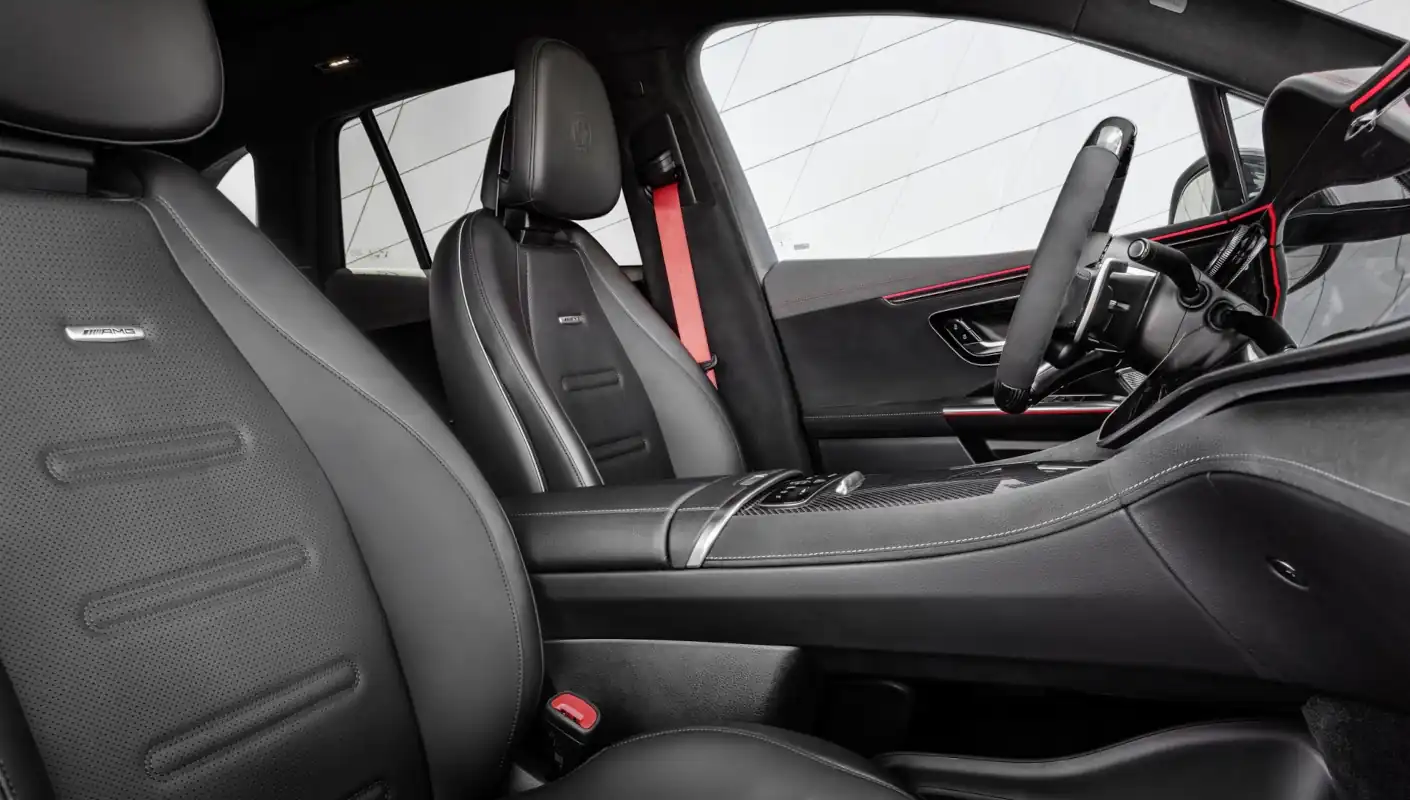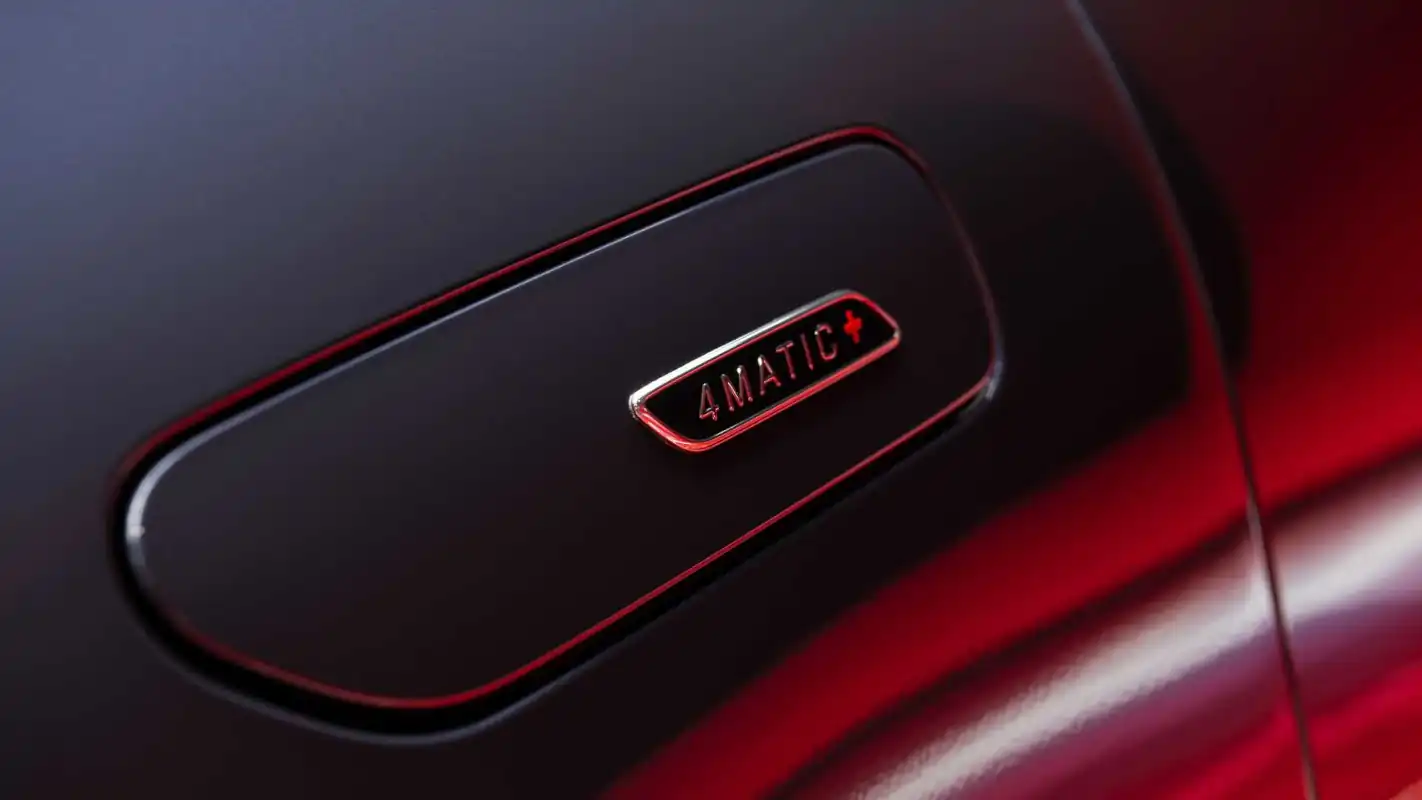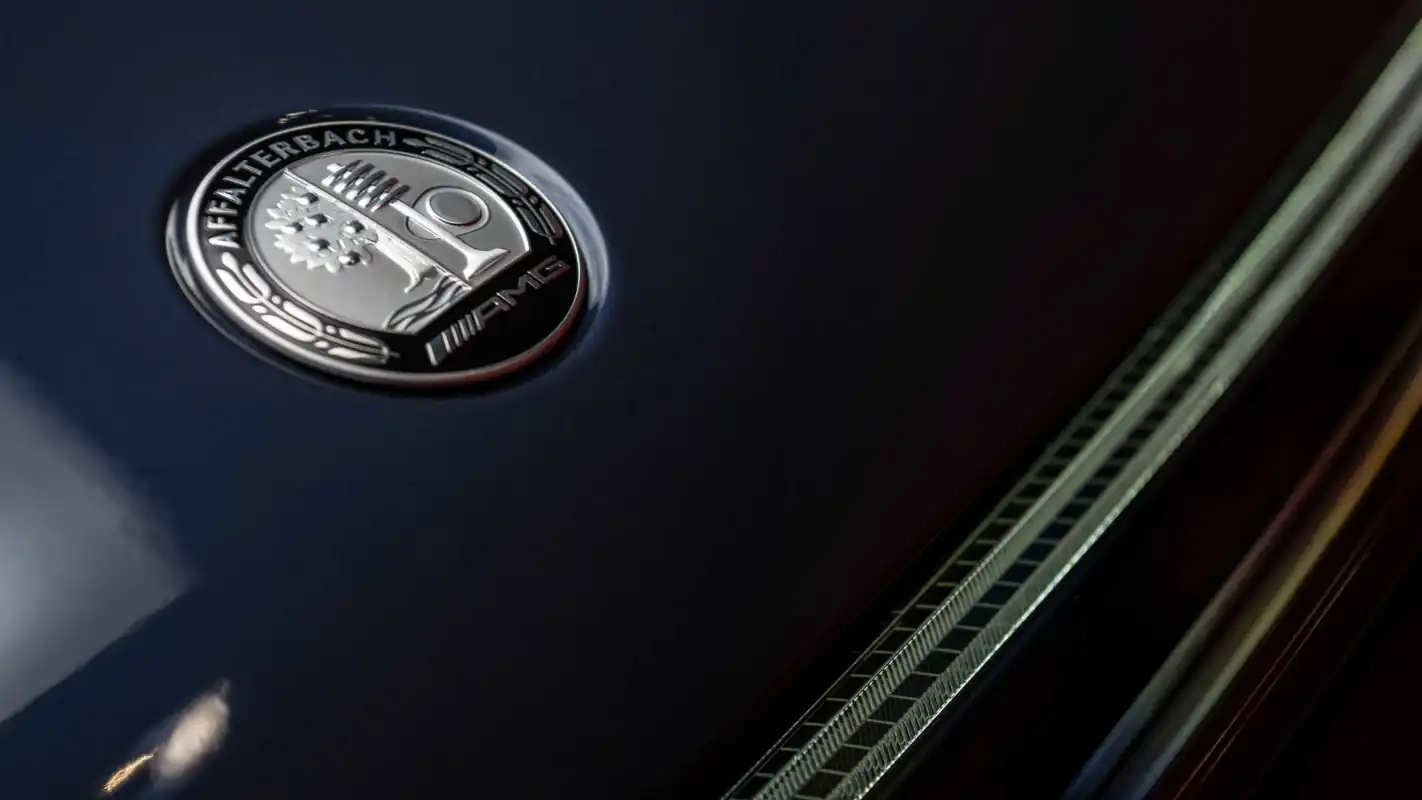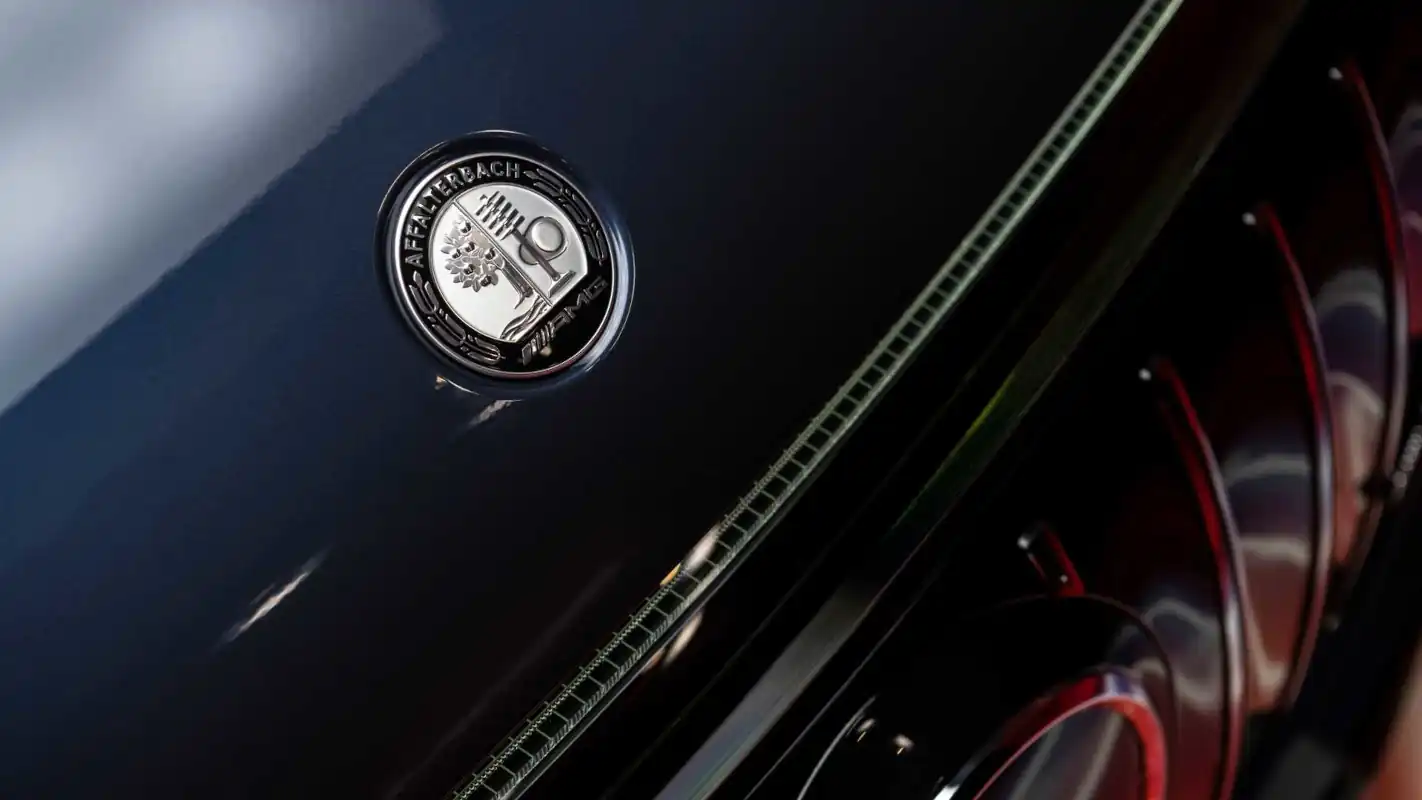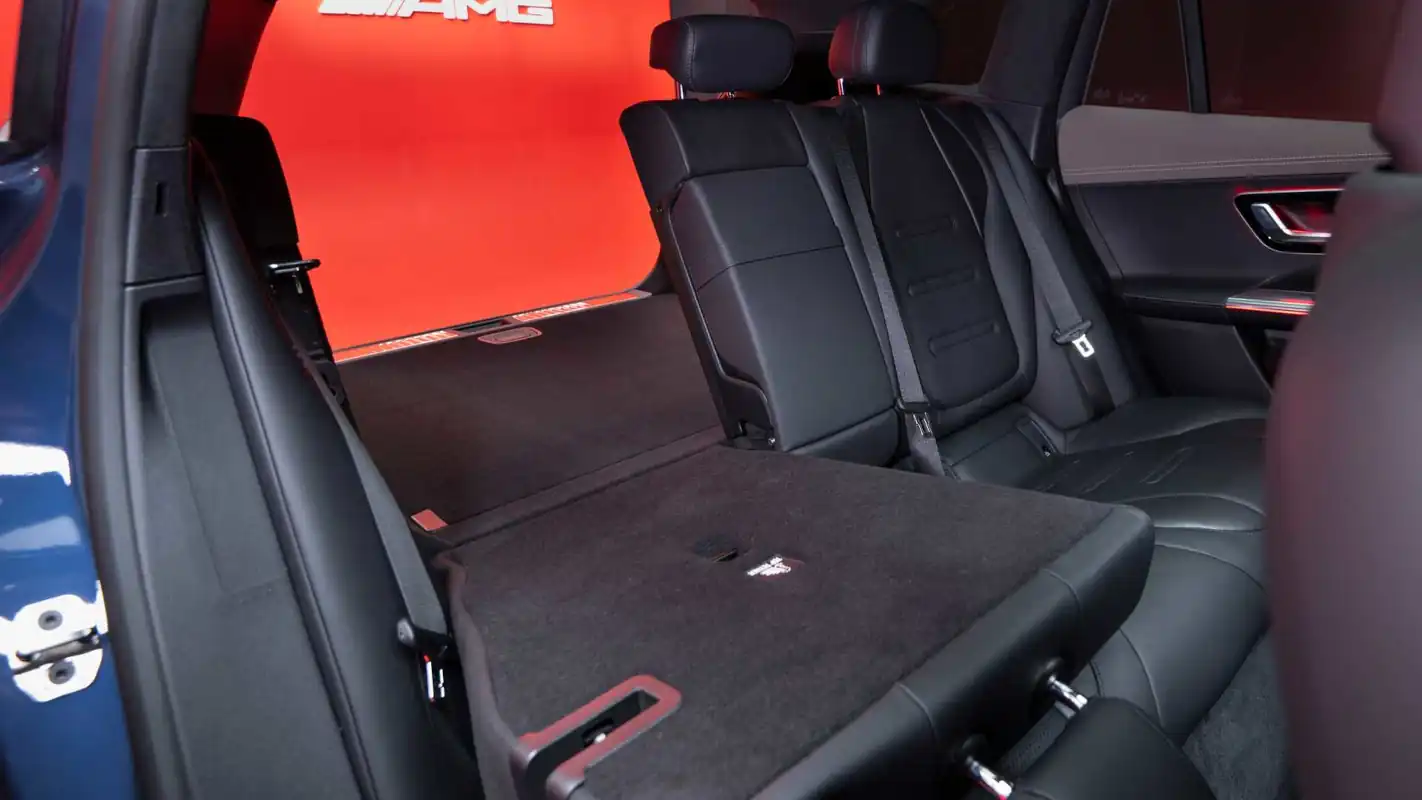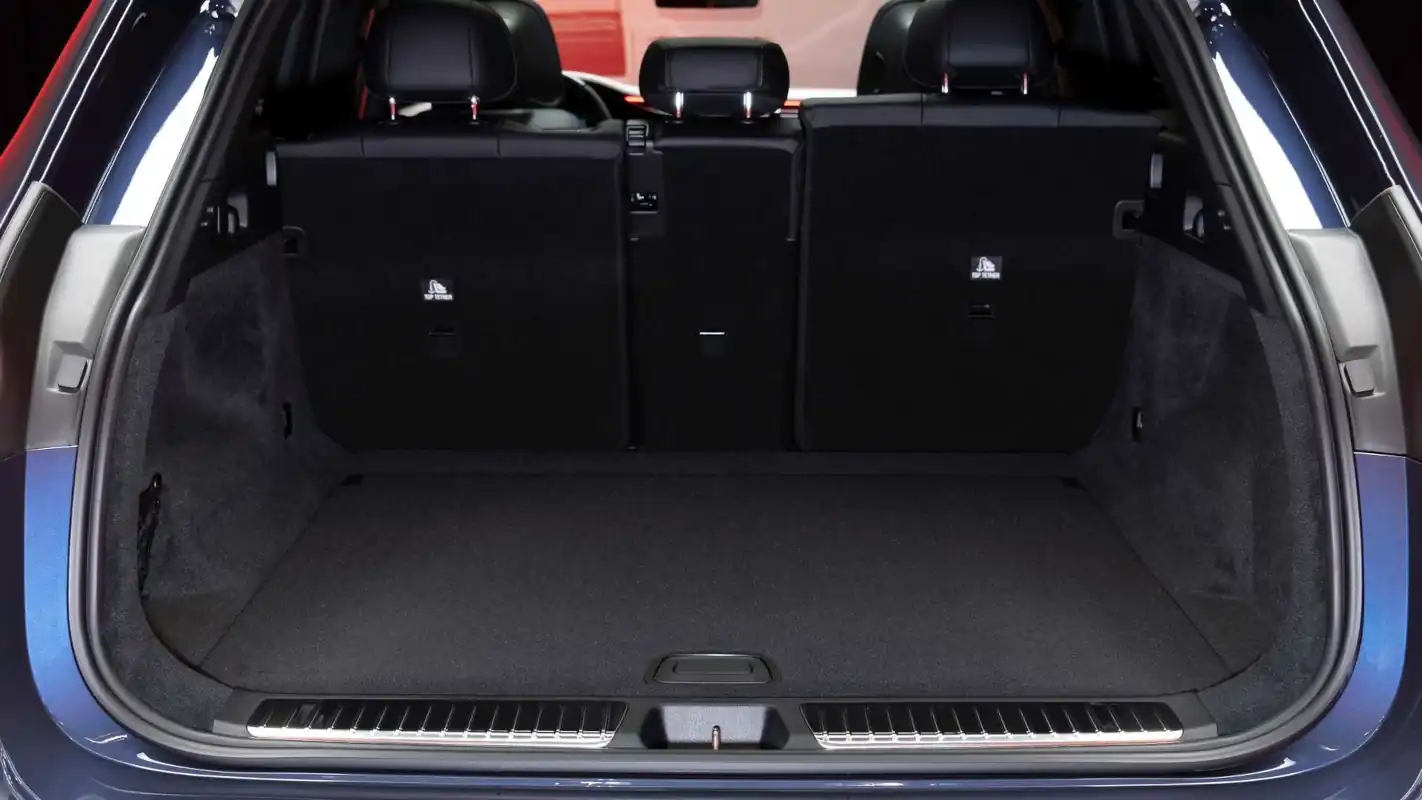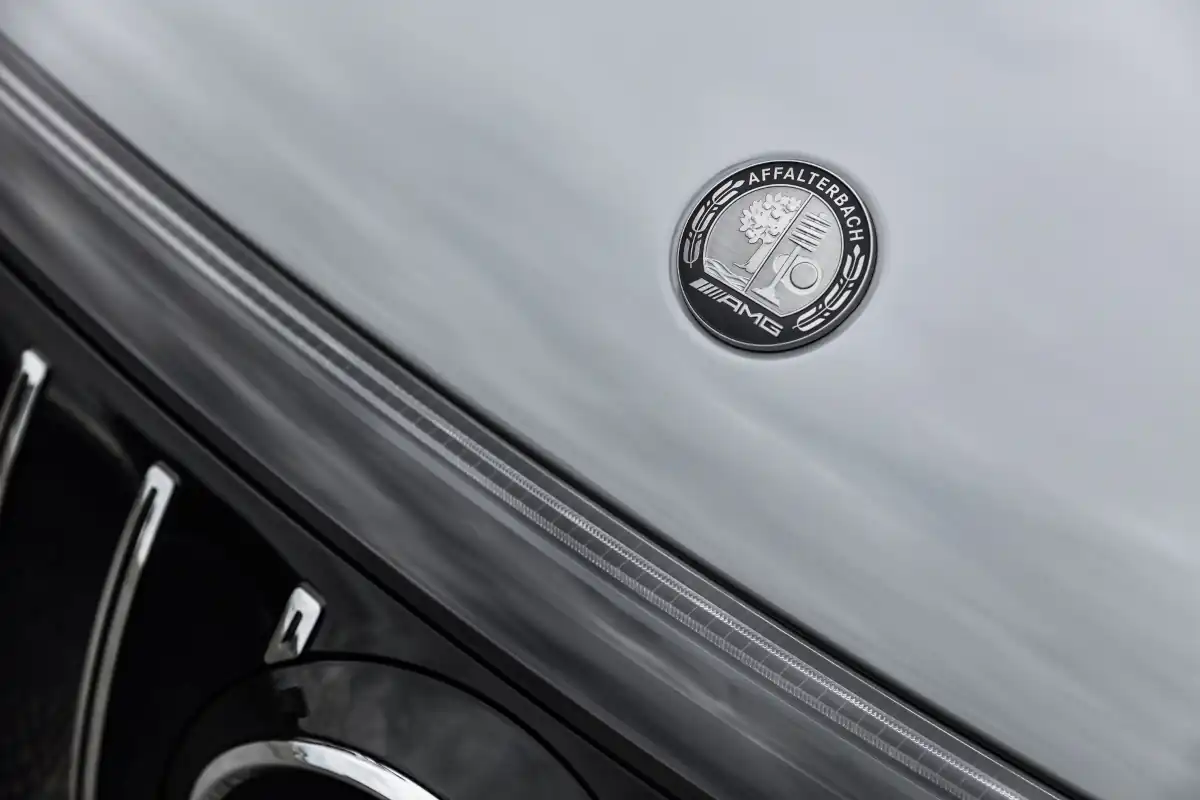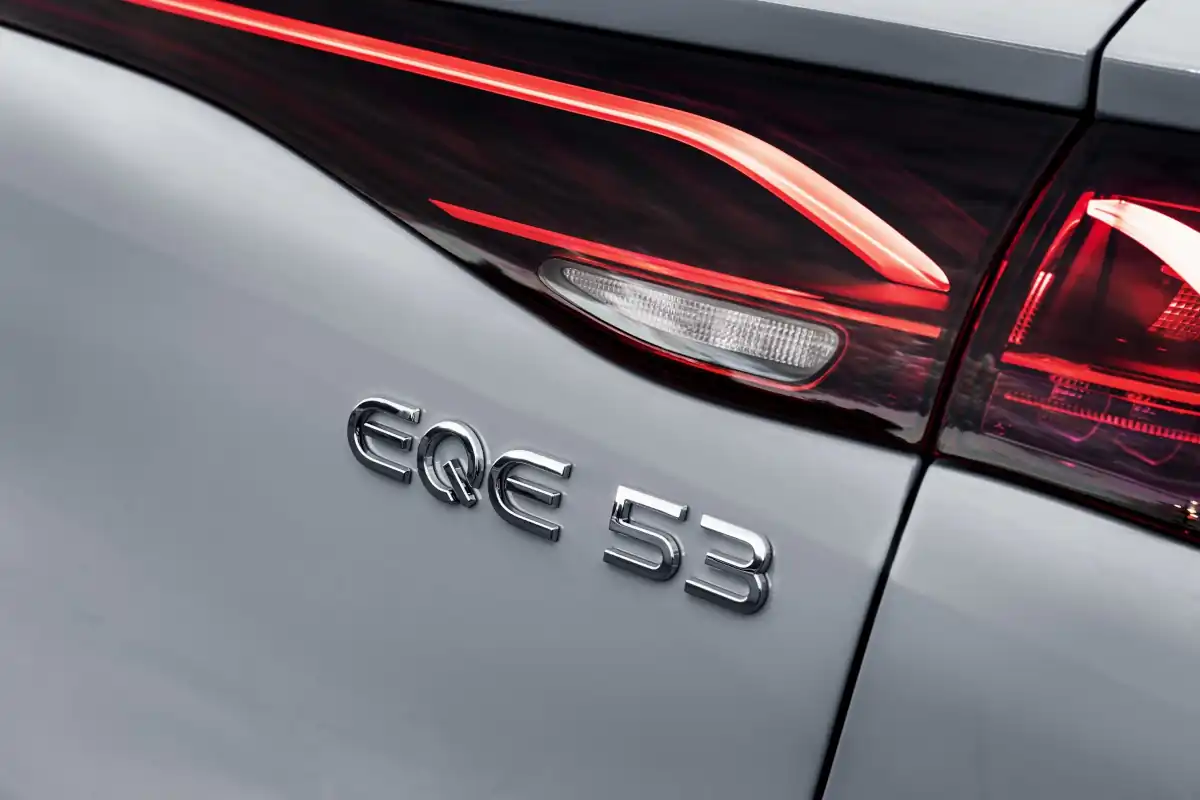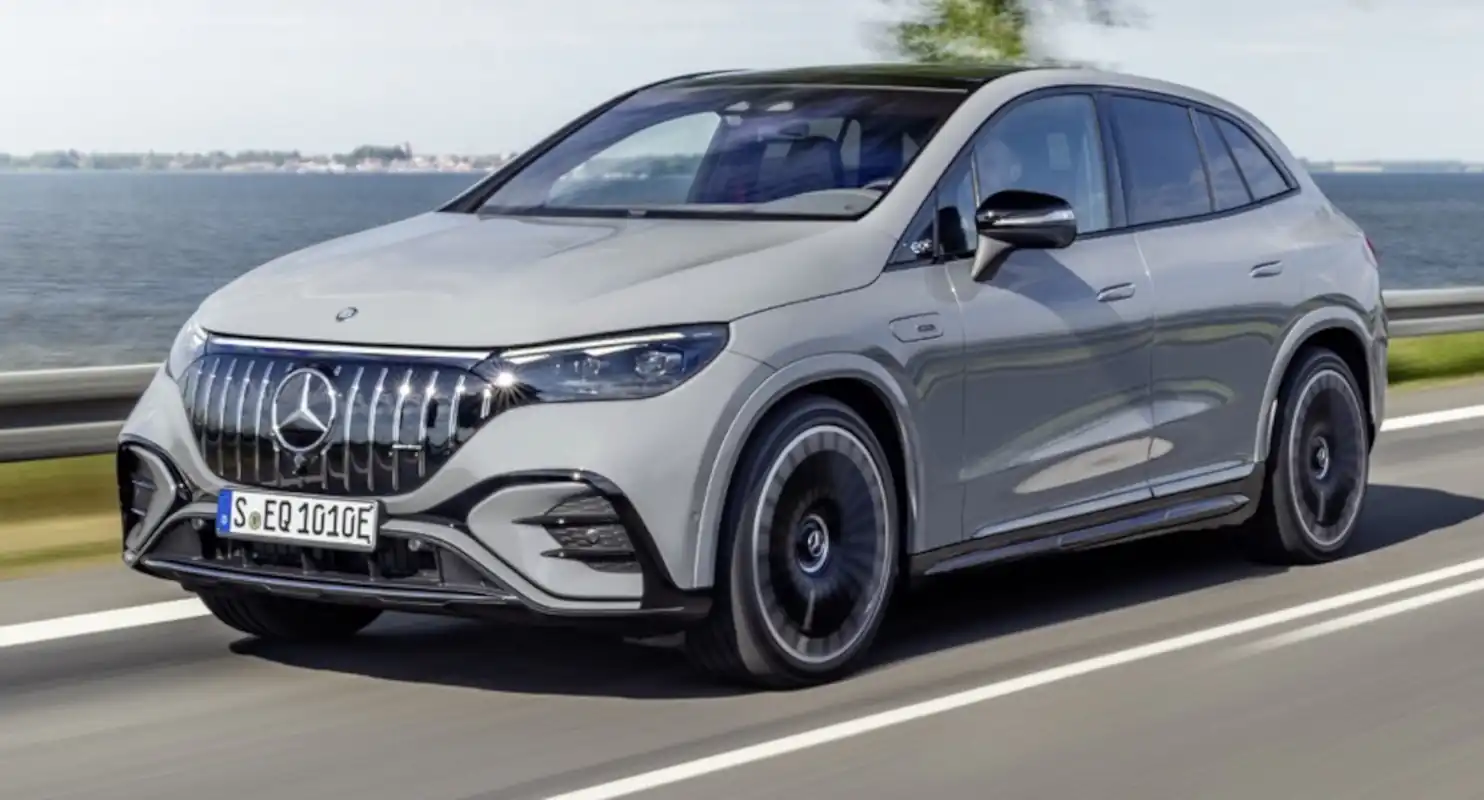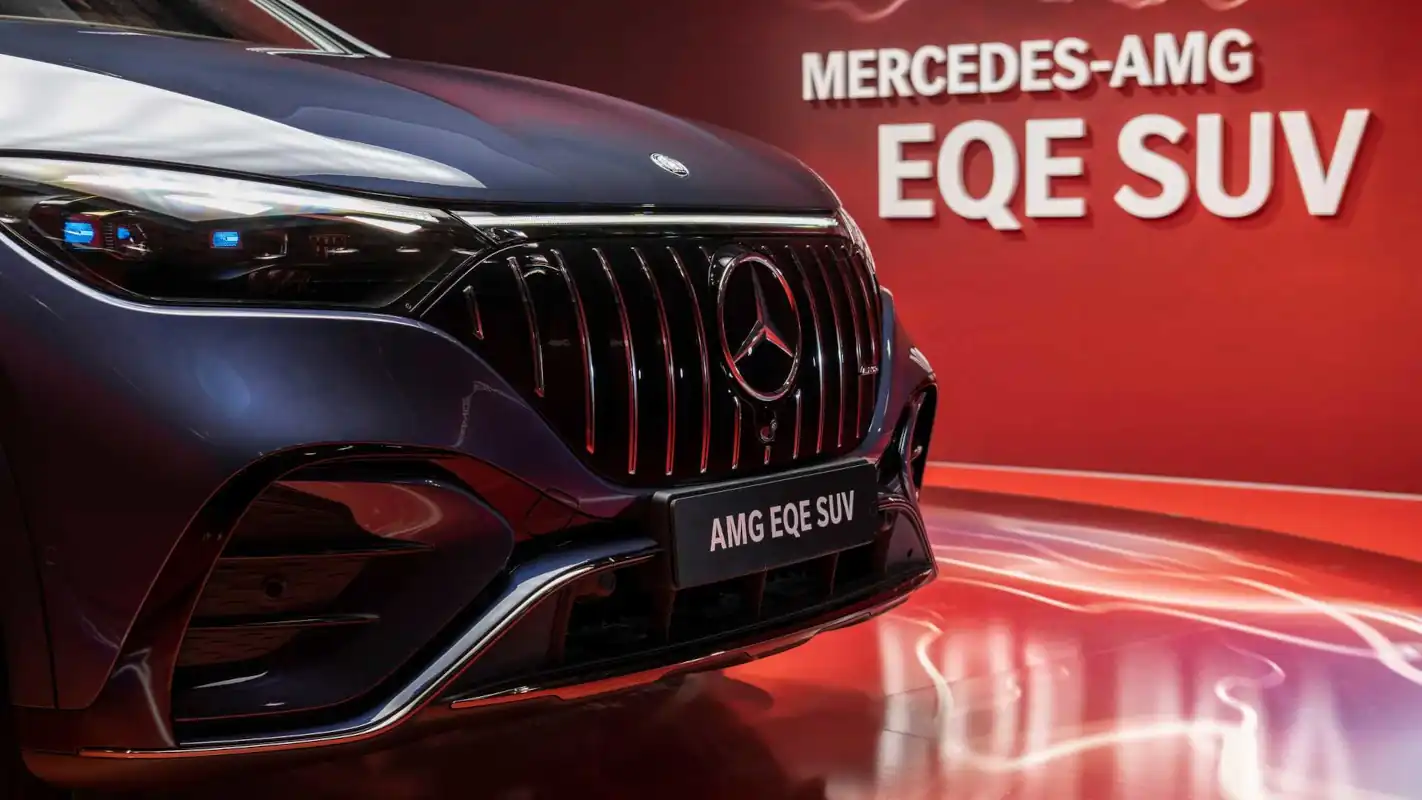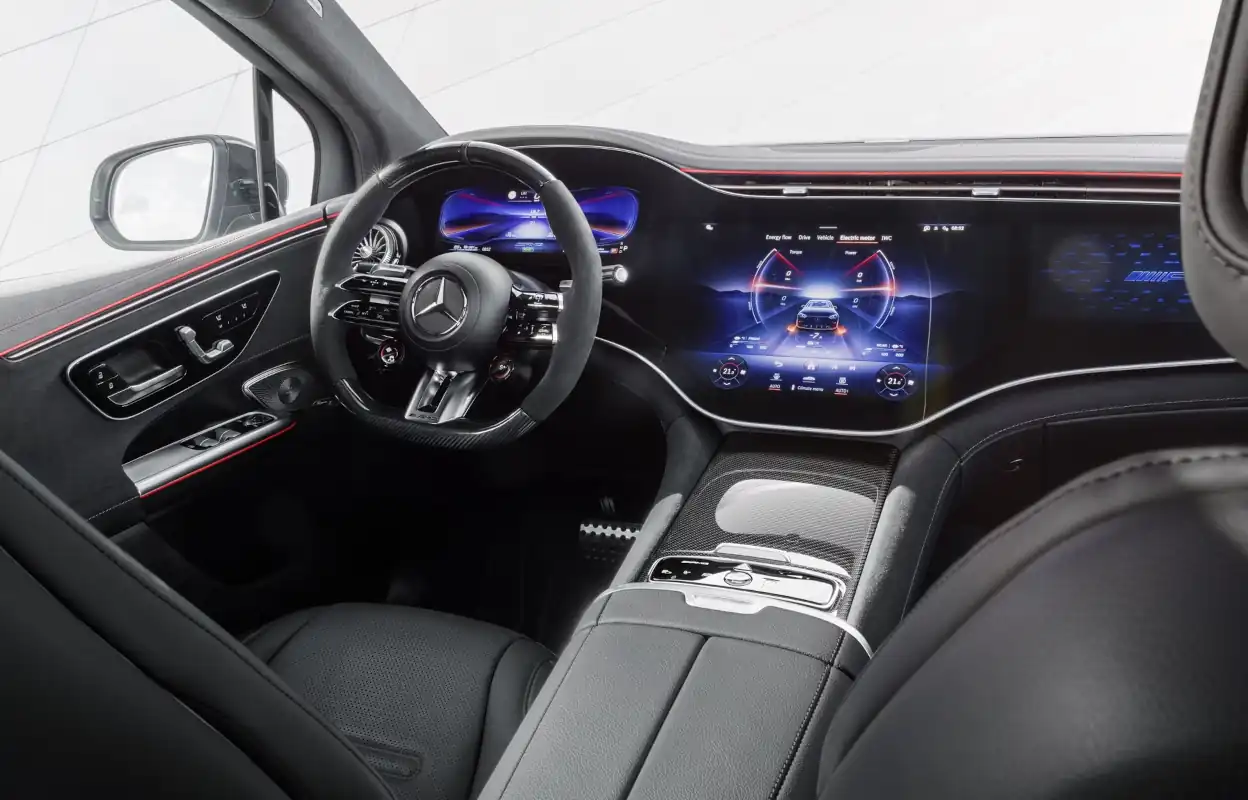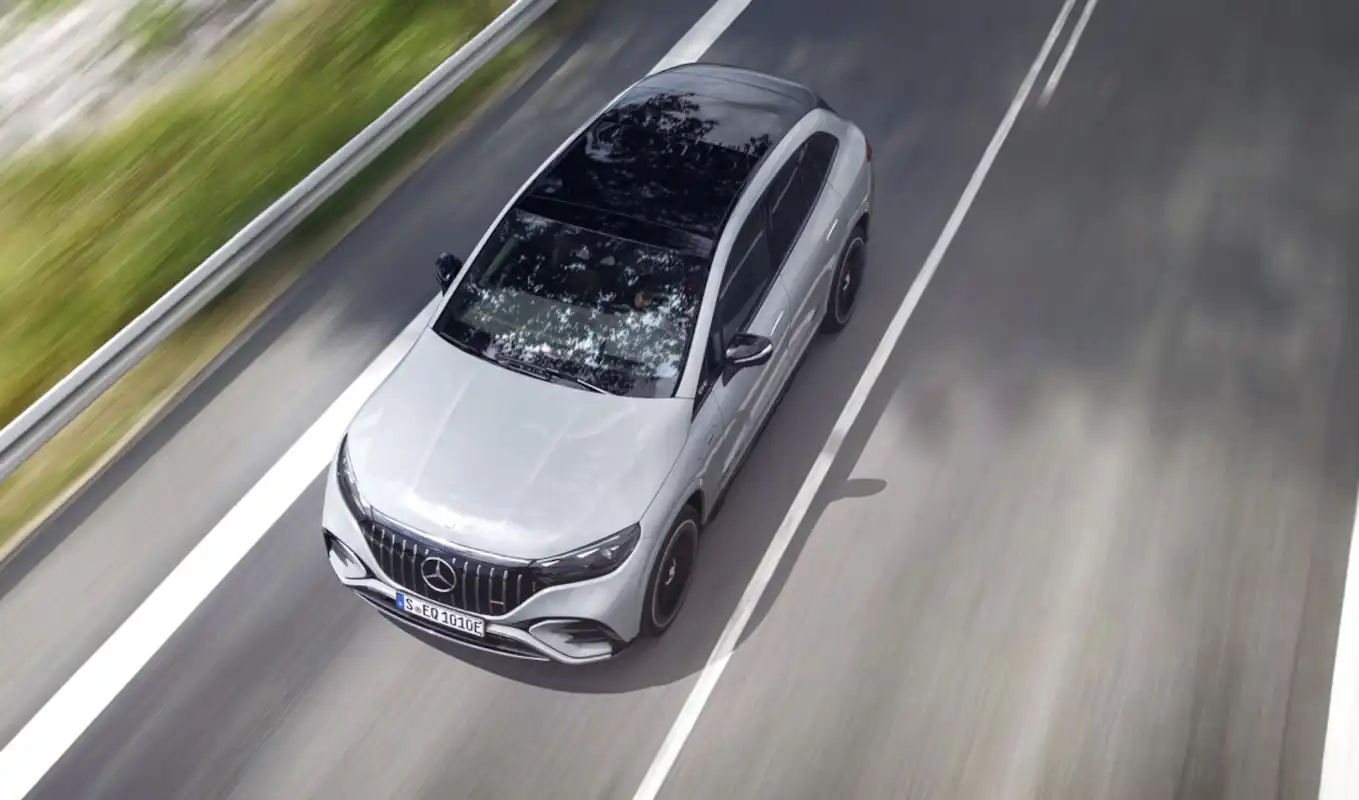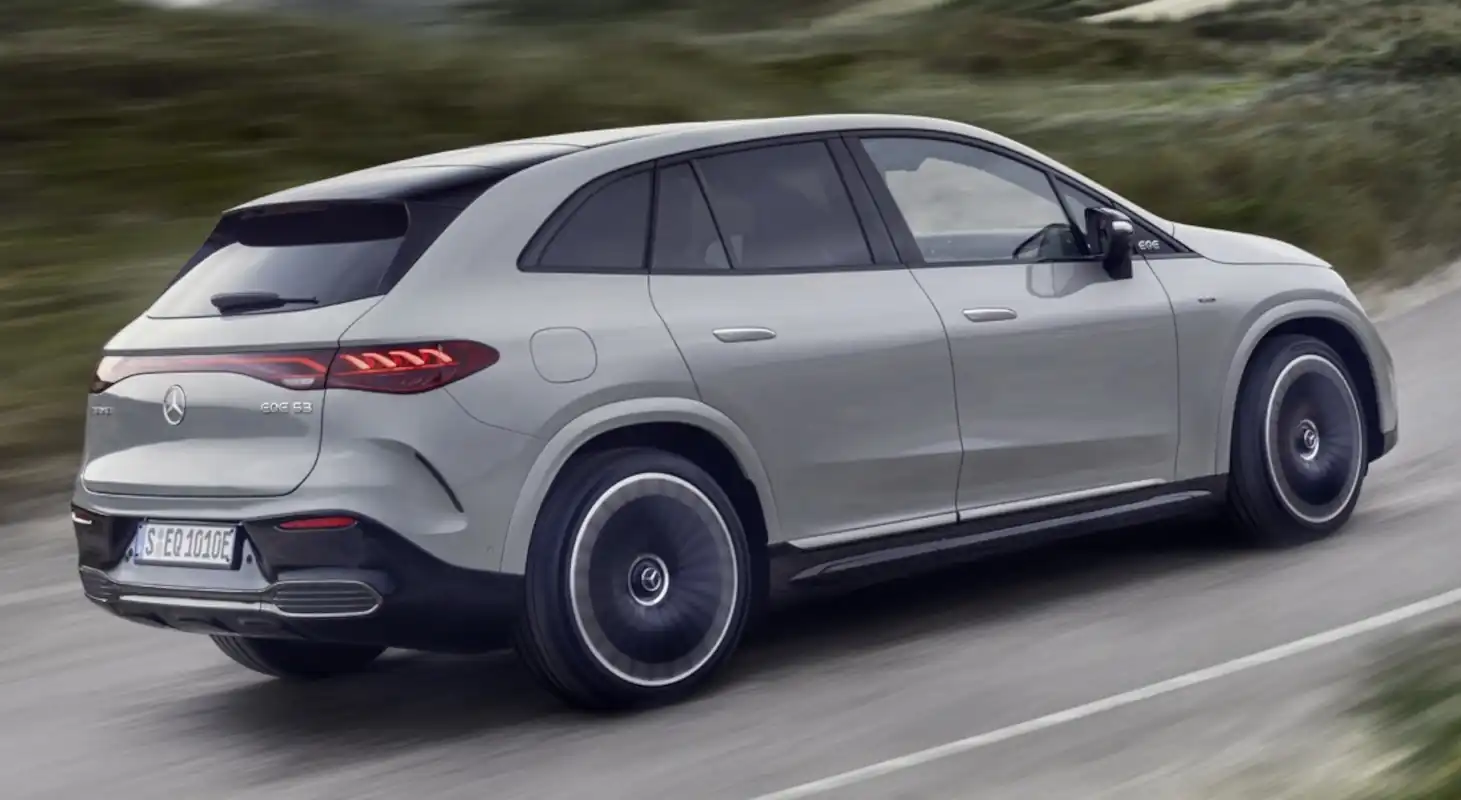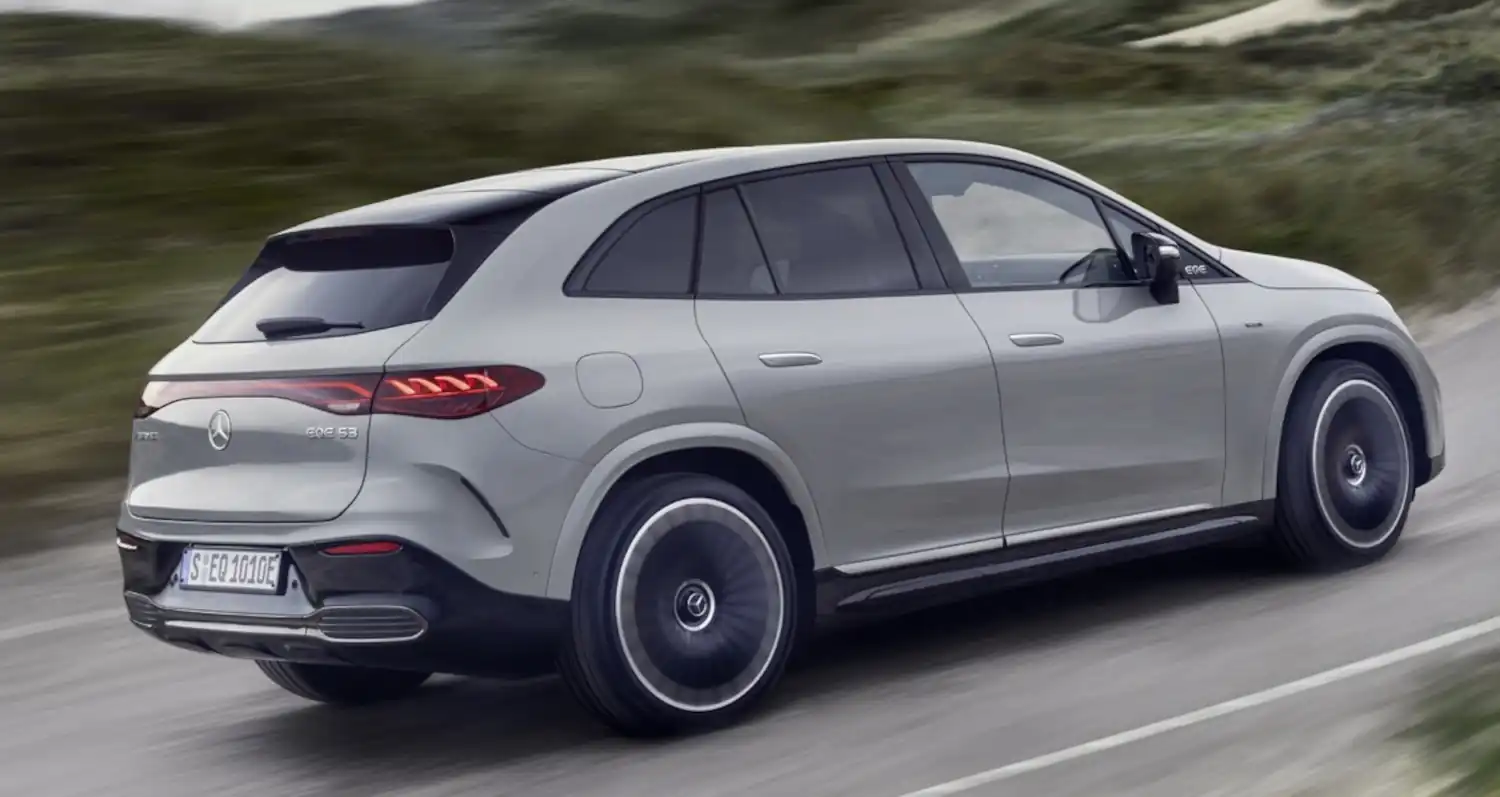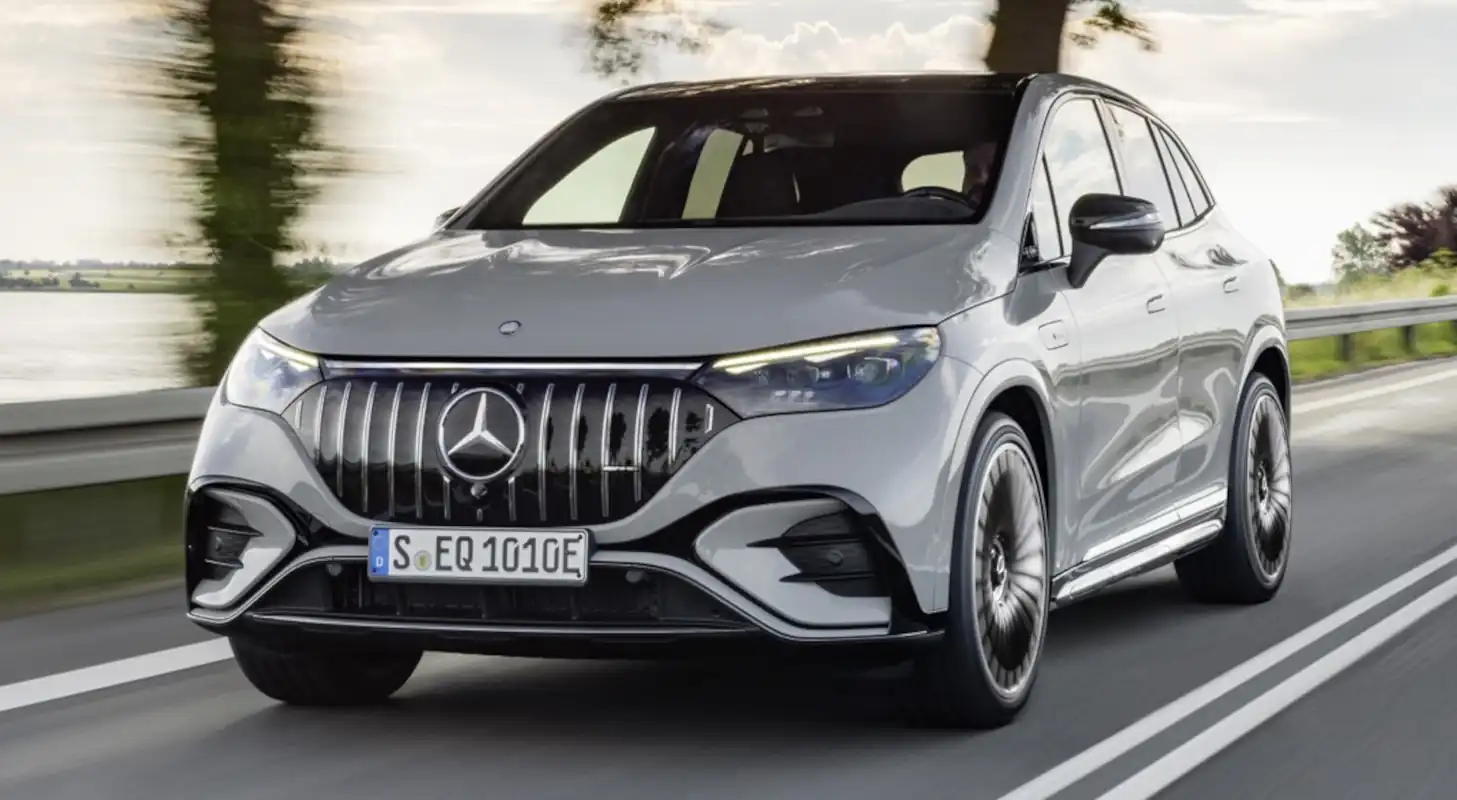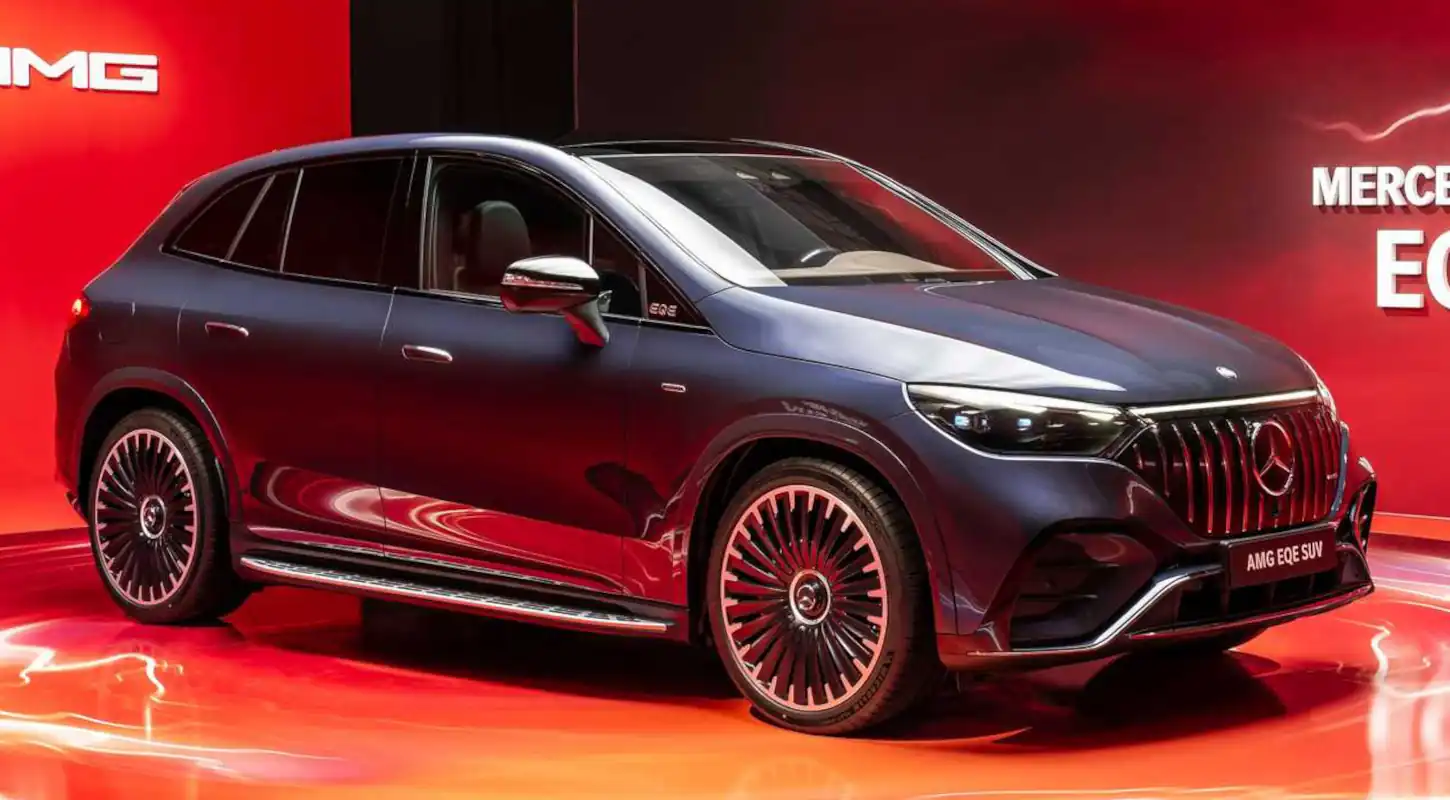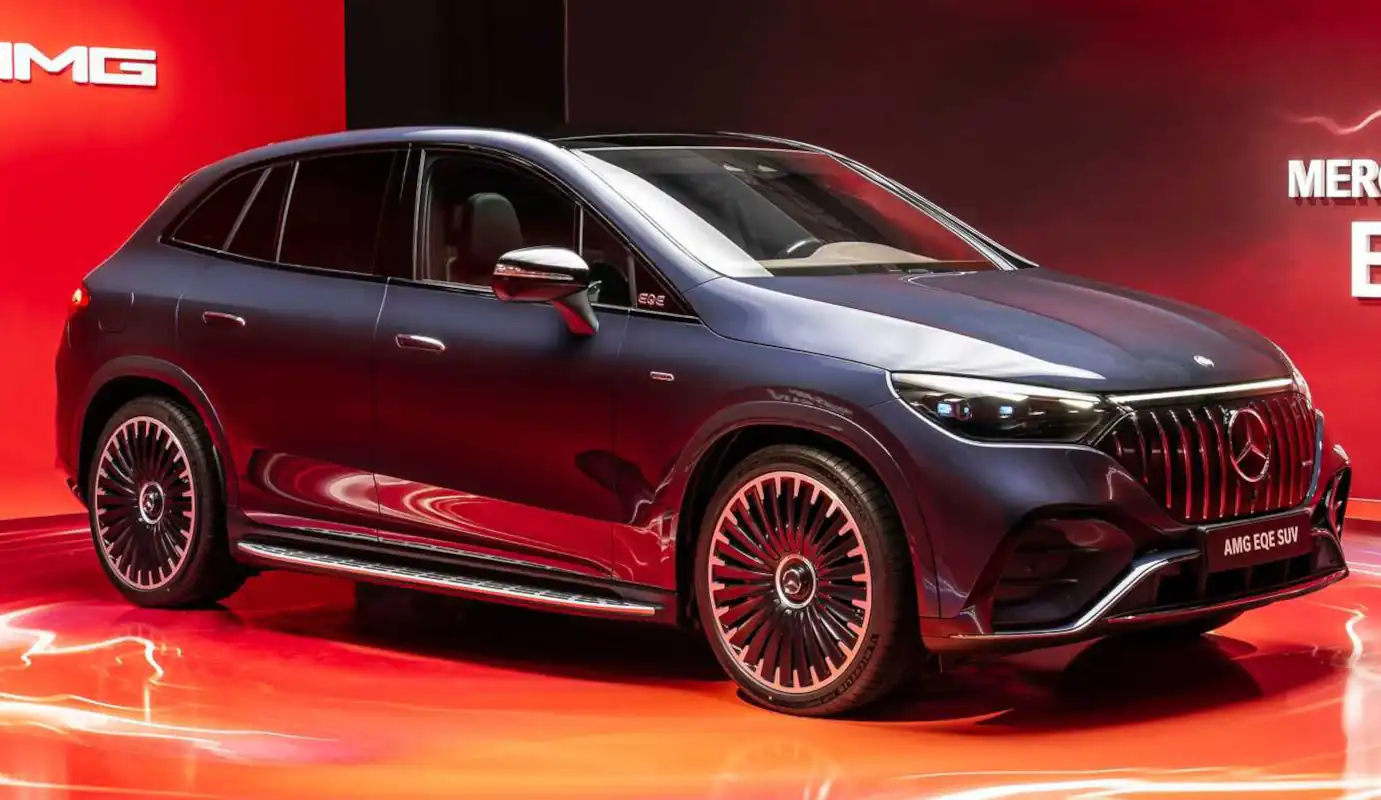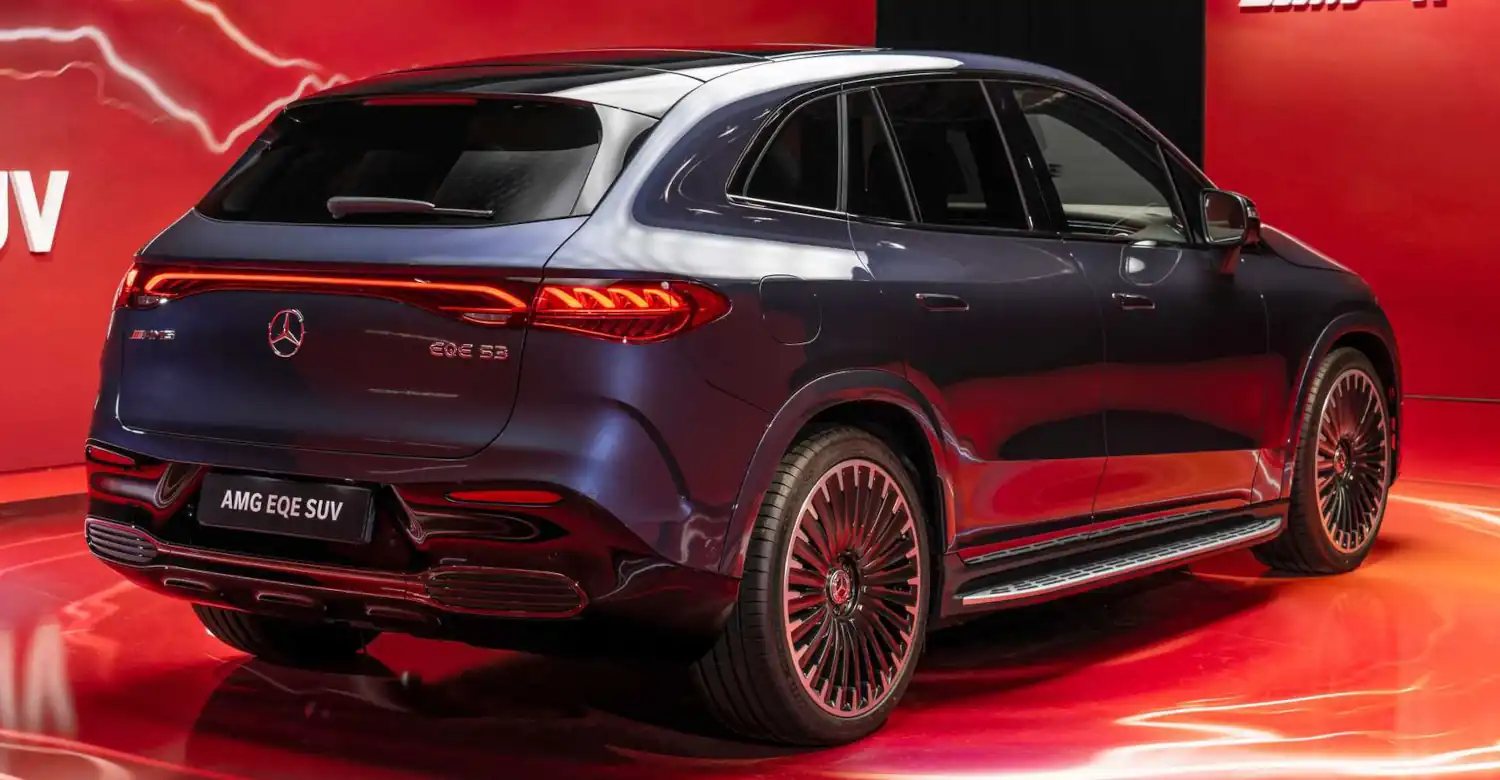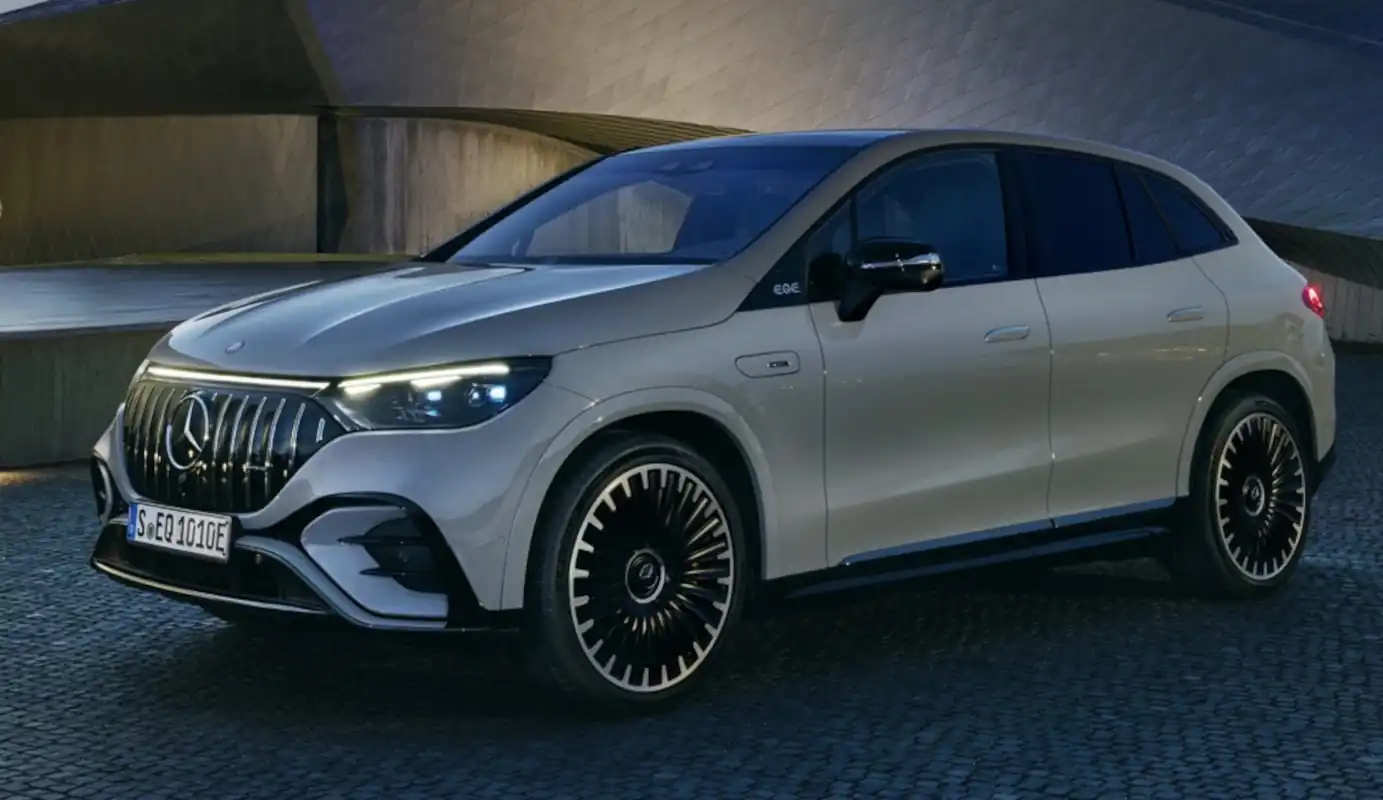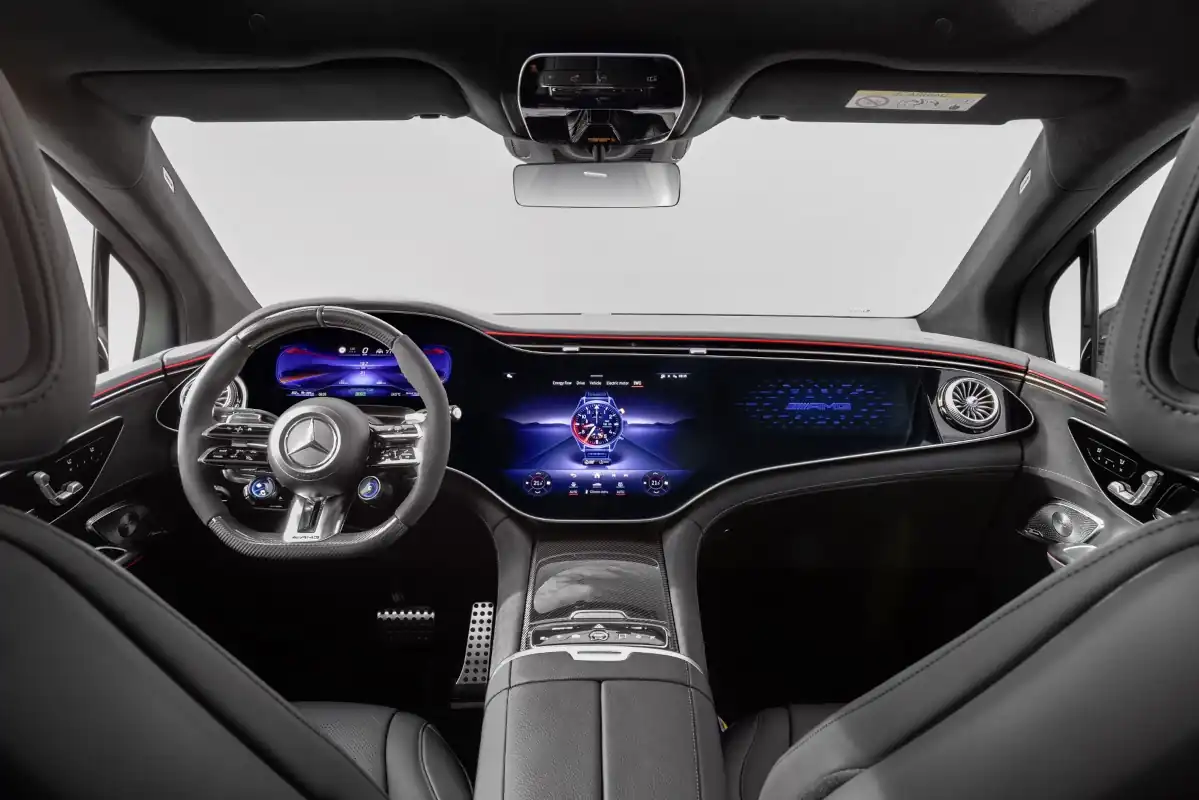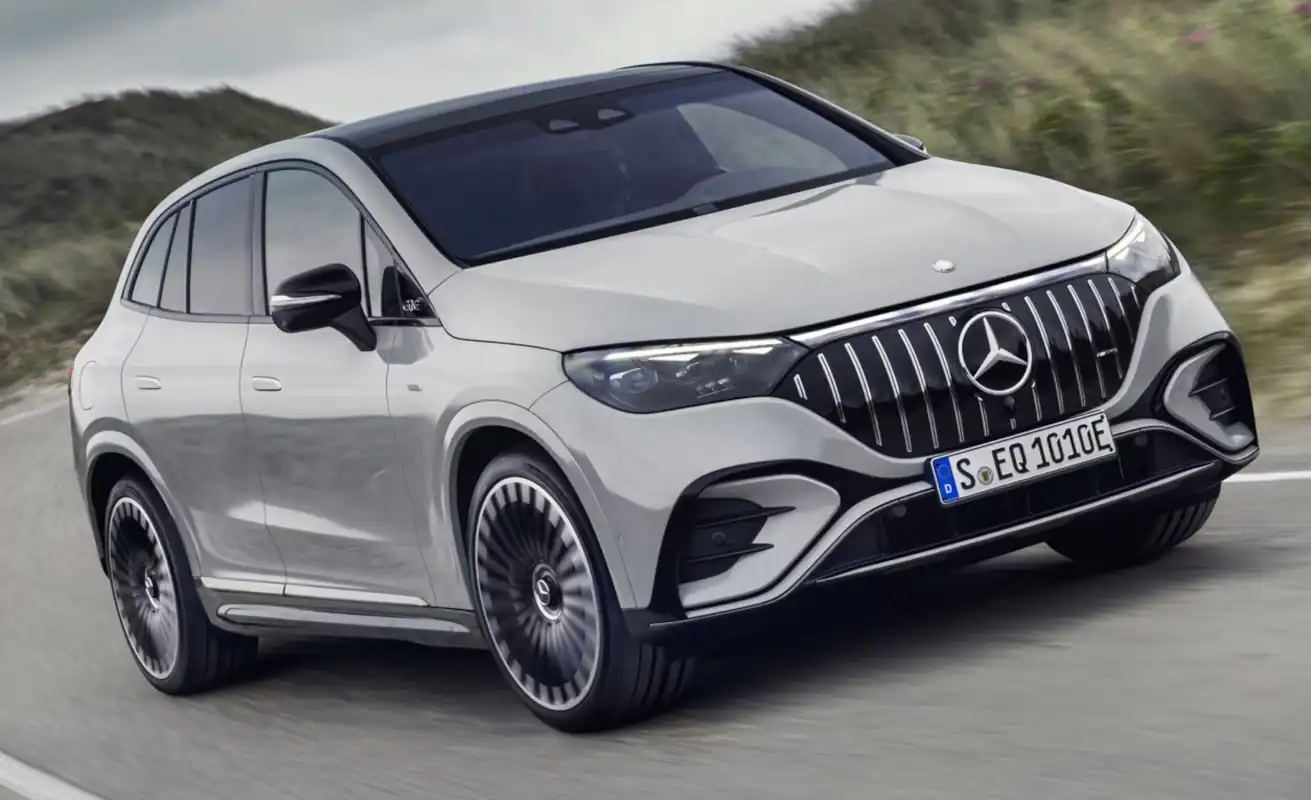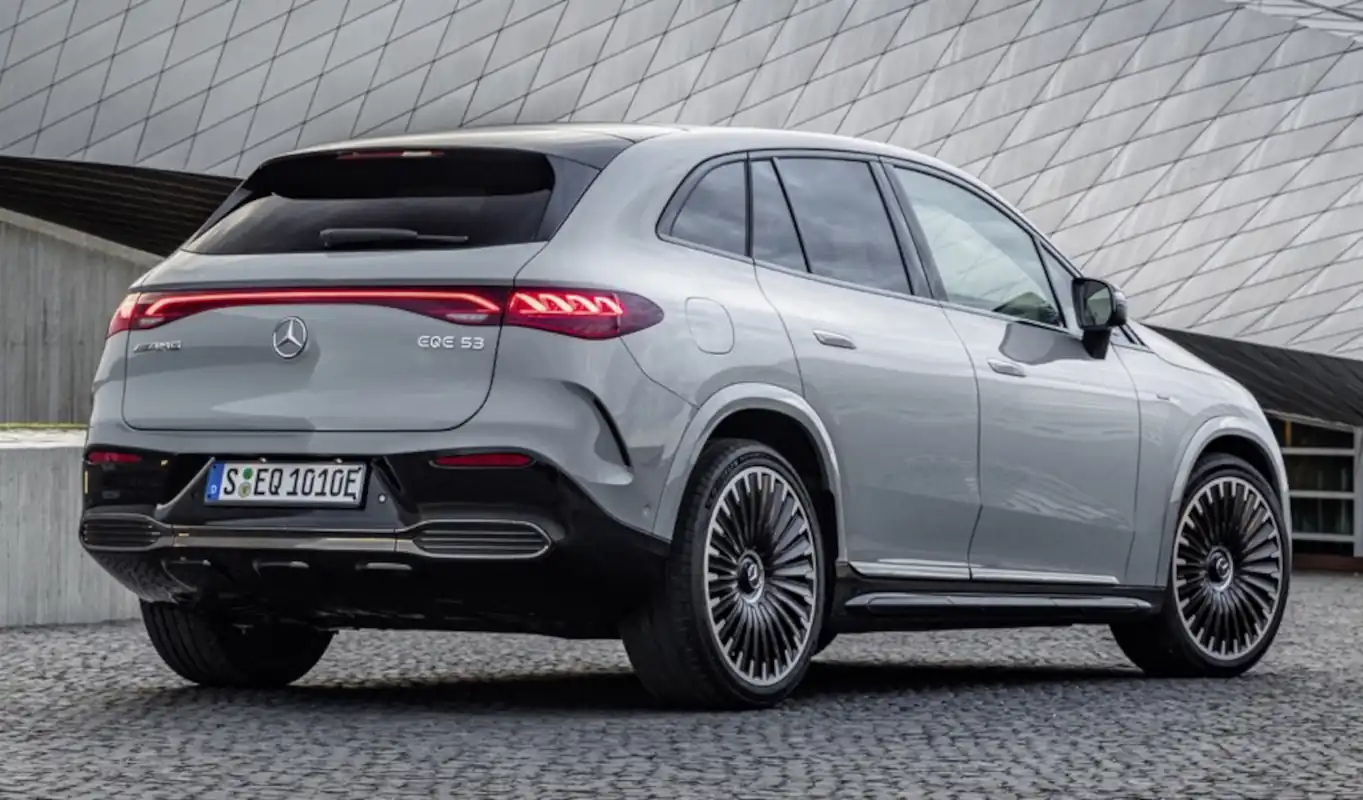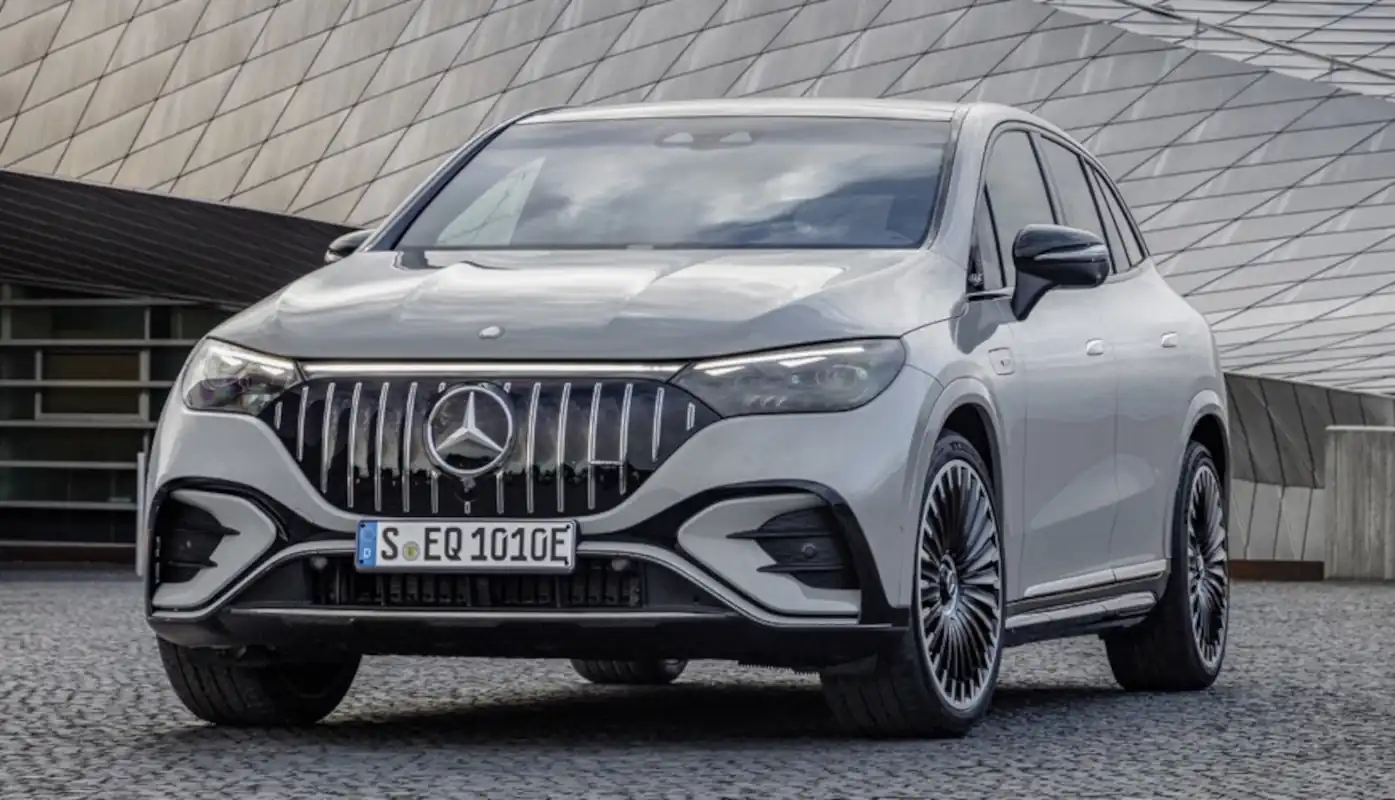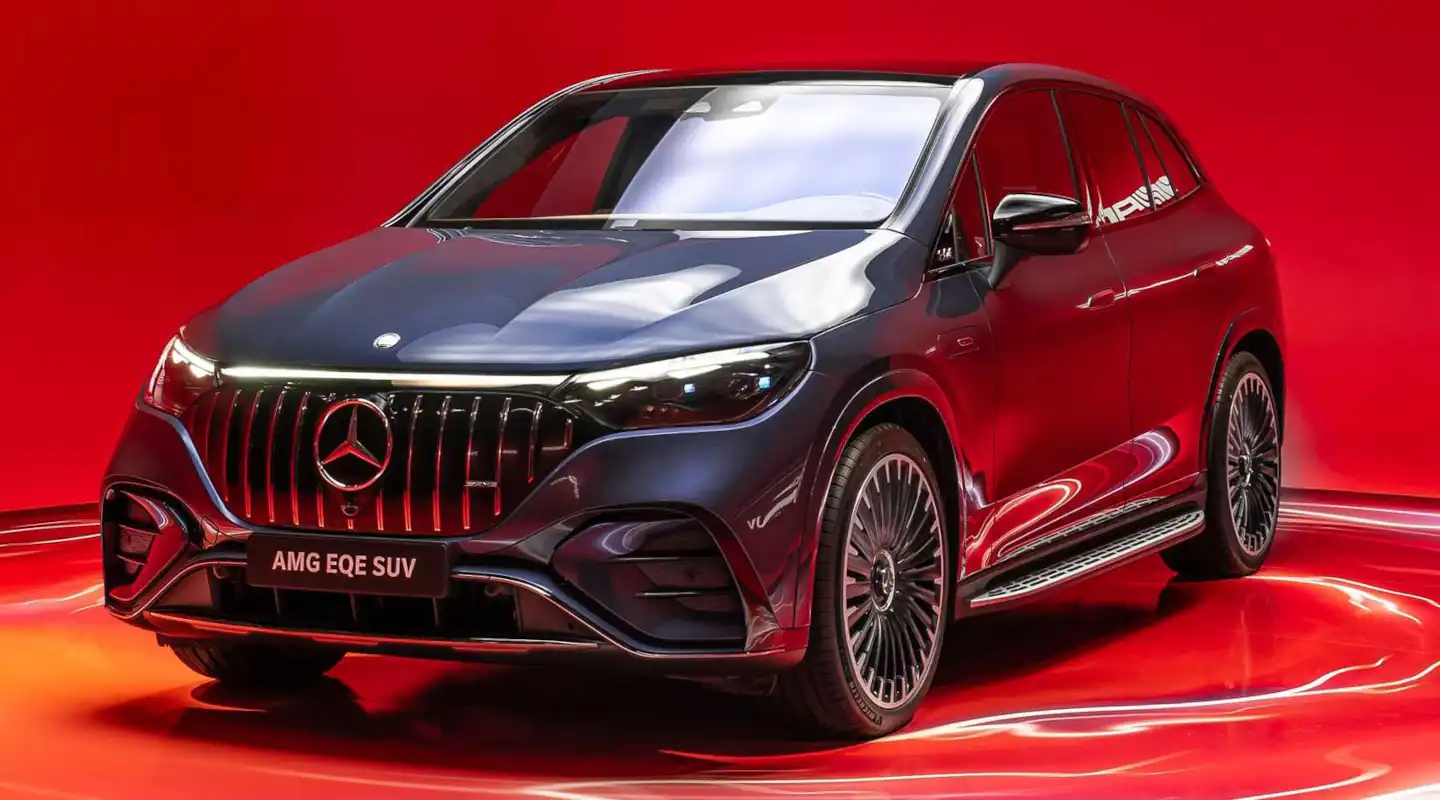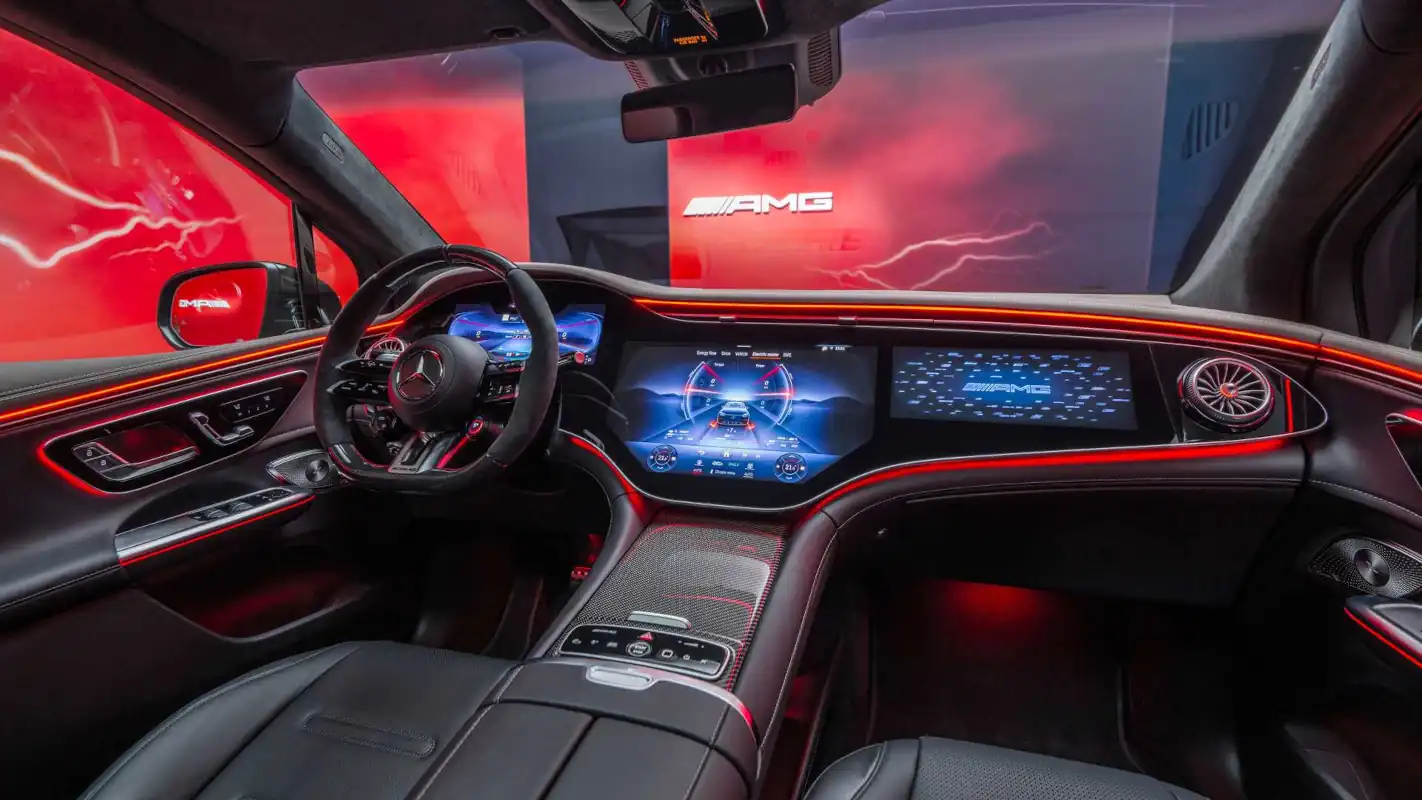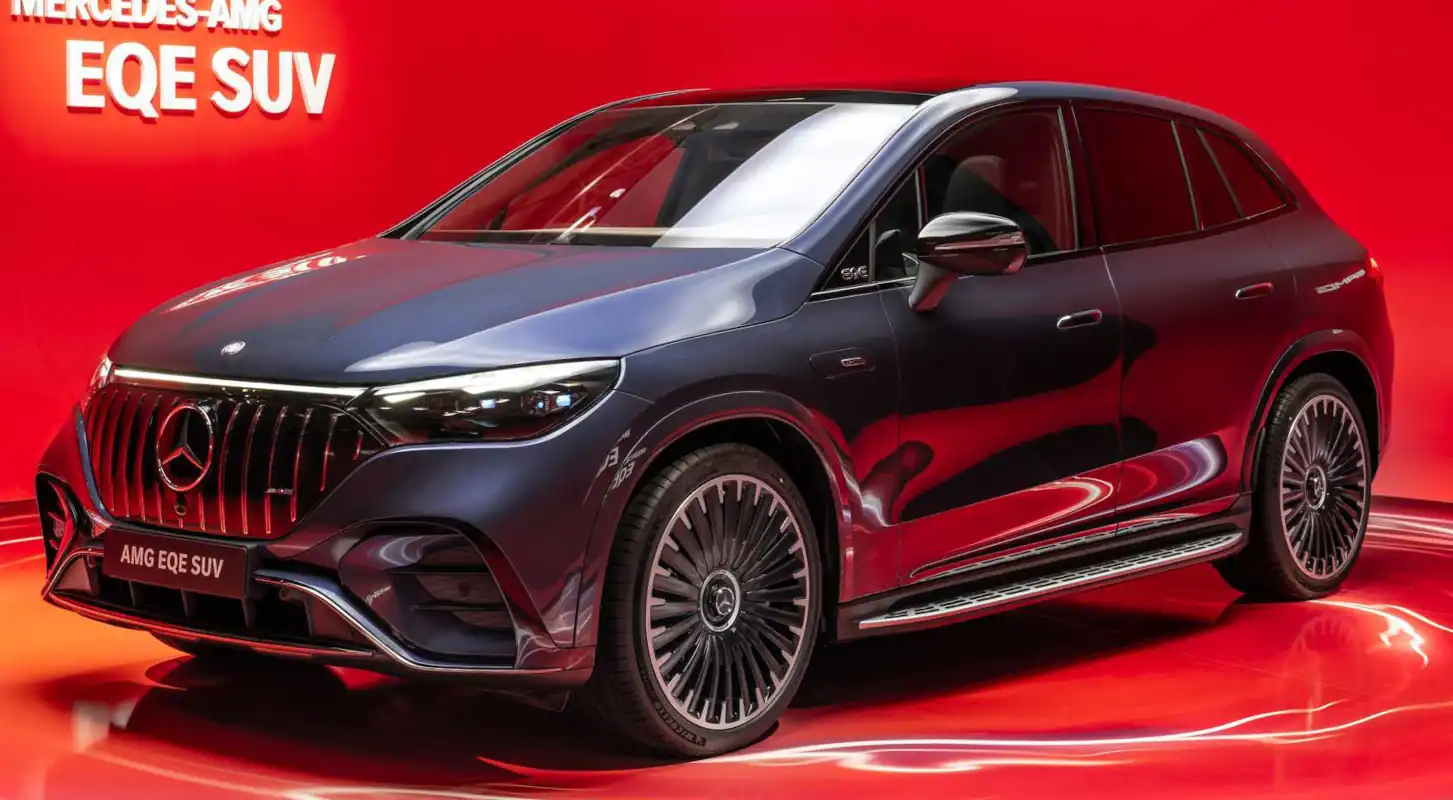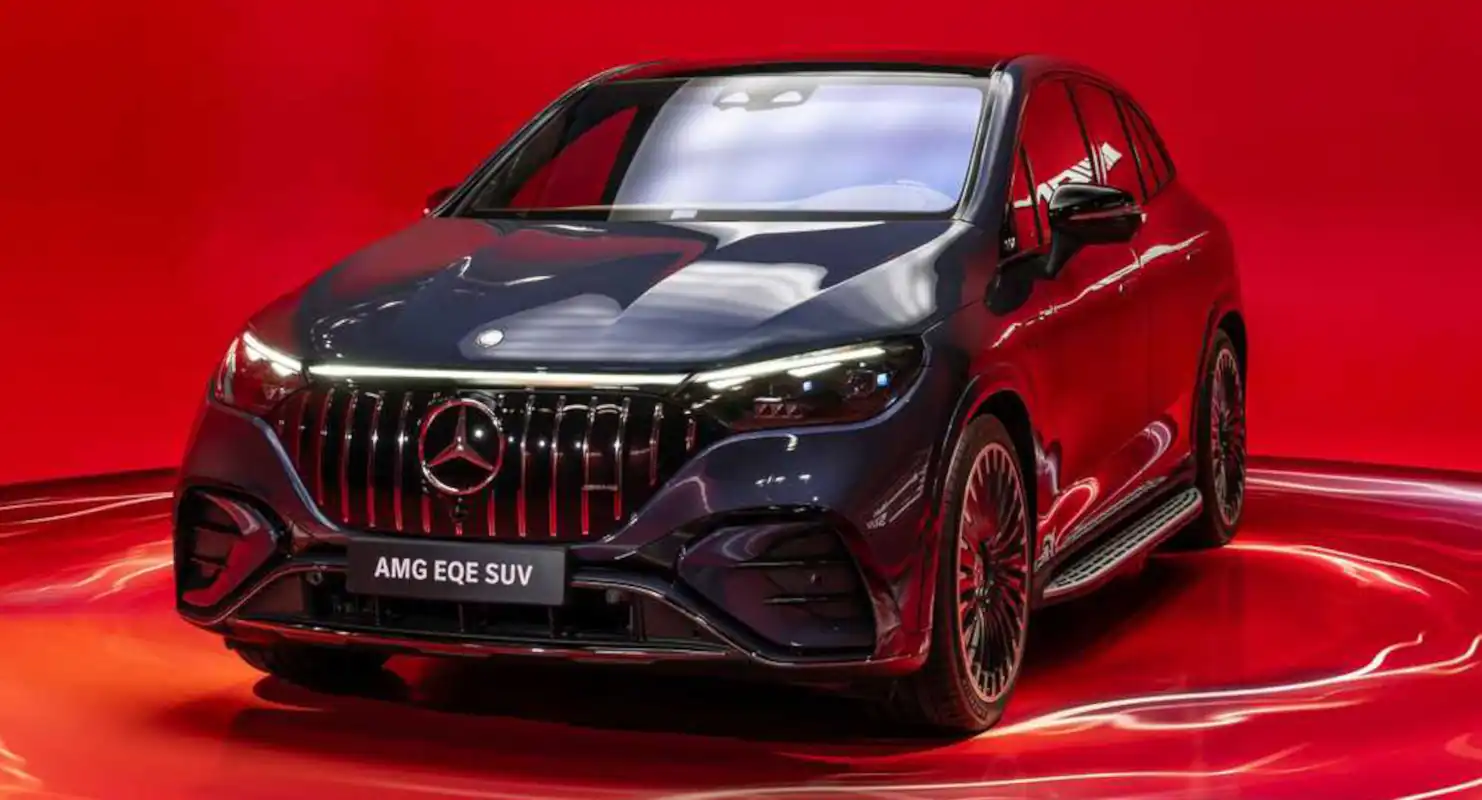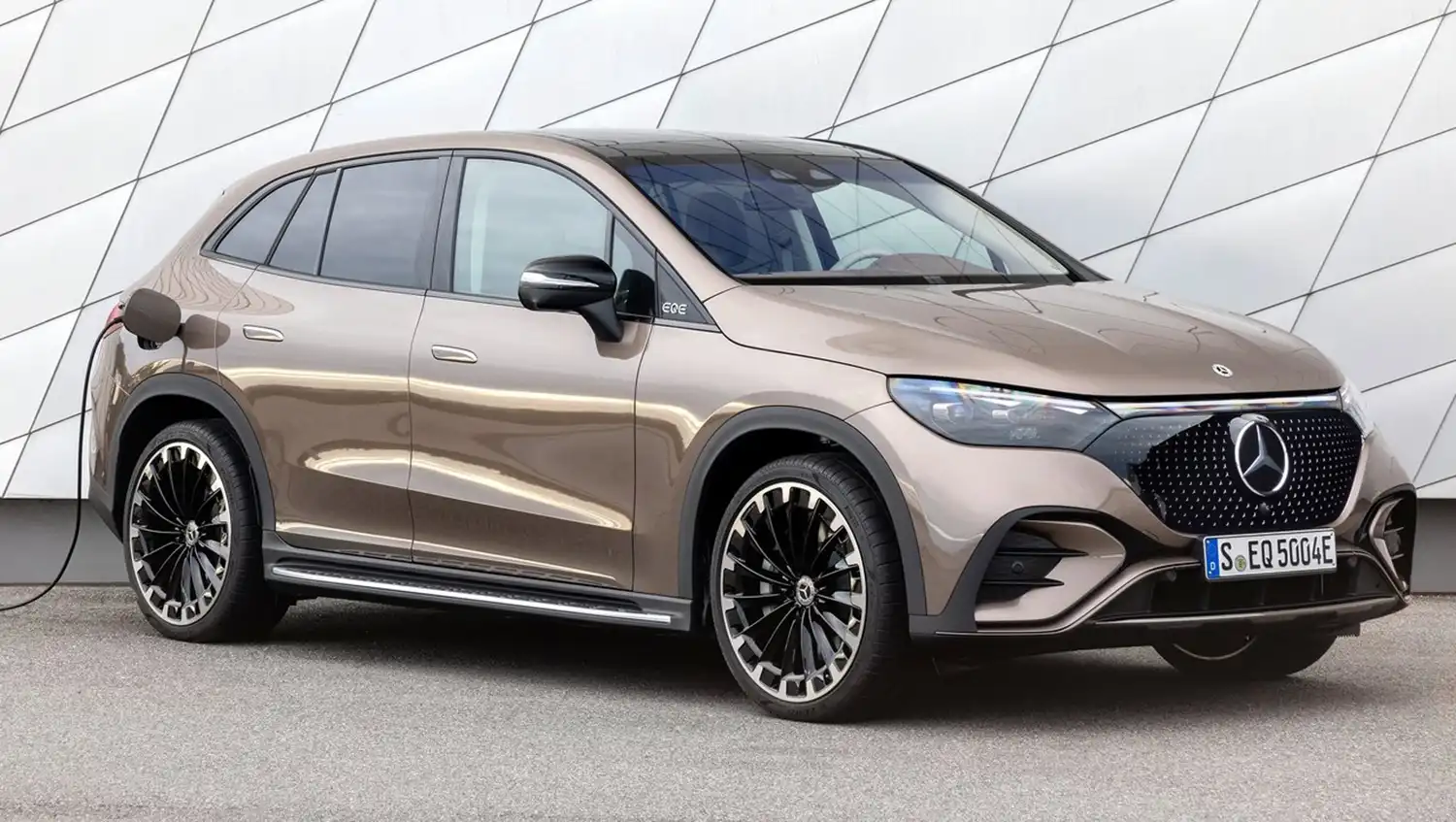
Mercedes-Benz EQE SUV (The Regular Model)
The EQE SUV is the multi-purpose variant of the EQE executive saloon. Like the latter, it is available with the essential innovations of the EQS and at the same time is more dynamic than the EQS SUV. The EQE SUV is one of the most spacious representatives of its class. Yet it is more compact than the EQE Saloon and, at 3030 millimetres, has a wheelbase that is nine centimetres shorter. The external dimensions are 4863/1940/1686 millimetres (length/width/height). As the fourth model after the two EQS and EQE Saloons as well as the EQS SUV, the EQE SUV uses the new all-electric platform.
Up to 590 kilometres range
The modular drive concept enables the EQE SUV to offer a wide range of maximum total drive outputs from 215 to 300 kW. Depending on the vehicle equipment and configuration, the European vehicles can achieve WLTP ranges of up to 590 kilometres. In the EQE SUV, the lithium-ion battery consists of ten modules. In certain cases the innovative battery management software, which was developed in-house, can be updated over-the-air (OTA).
Extensive range of driving assistance systems
The current generation of driving assistance systems includes numerous functions that support the driver. The general standard equipment of the EQE SUV includes ATTENTION ASSIST, Active Brake Assist, Active Lane Keeping Assist, Parking Package with reversing camera and Speed Limit Assist. The status and activity of the systems are shown in a full-screen view in the assistance display in the driver’s display. Further options are available in the Assistance Package and also the Driving Assistance Plus Package.
Particularly manoeuvrable and agile
The chassis of the new EQE SUV comprises a four-link suspension at the front and an independent multi-link suspension at the rear. Due to the comparatively short wheelbase of 3030 millimetres and the corresponding suspension tuning, it feels particularly agile and manoeuvrable even with the basic set-up. The AIRMATIC air suspension with ADS+ continuously adjustable damping is available as an optional extra. To increase ground clearance, the vehicle level can be raised by up to 30 millimetres. In addition to the DYNAMIC SELECT programs of ECO, COMFORT, SPORT and INDIVIDUAL, the EQE SUV models with 4MATIC also boast the OFFROAD program for off-road driving. A rear axle steering system with a maximum steering angle of 10 degrees is available as an option.
Always up to date
The EQE SUV offers the possibility of activating additional vehicle functions via over-the-air technology (OTA) in a number of functional areas. This means that after purchase and having chosen the original new car configuration, some of the EQE SUV’s equipment can be individually customised. The OTA functions are available in the Mercedes me Store, and the range will be successively expanded.
MBUX Hyperscreen on request
With adaptive software, the MBUX display and operating system makes personalised suggestions for numerous infotainment, comfort and vehicle functions. A highlight of the interior is the optional MBUX Hyperscreen. With the zero-layer design, the user does not have to scroll through submenus or give voice commands. Situational and contextual applications are offered at the top level in the field of view. With the MBUX Hyperscreen (optional extra), three displays merge almost seamlessly into one another to create a screen band over 141 centimetres wide. The front passenger in the EQE SUV has the option of a 12.3-inch OLED display with its own user interface. The system uses an intelligent, camera-based blocking logic that recognises if the driver is looking toward the front passenger display. If this is the case, the system automatically dims the dynamic content for security reasons (see separate chapter).
Clever route planning
When it comes to Navigation with Electric Intelligence, the name says it all. For on the basis of numerous factors it plans the fastest and most convenient route including charging stops. It also reacts dynamically to traffic jams or a change in driving style, for example. Navigation with Electric Intelligence is clever; it calculates the estimated charging costs per charging stop. Furthermore, the customer can edit the planned routes individually. They can edit the planned routes individually by adding in preferred charging stations along the route or excluding proposed charging stations.
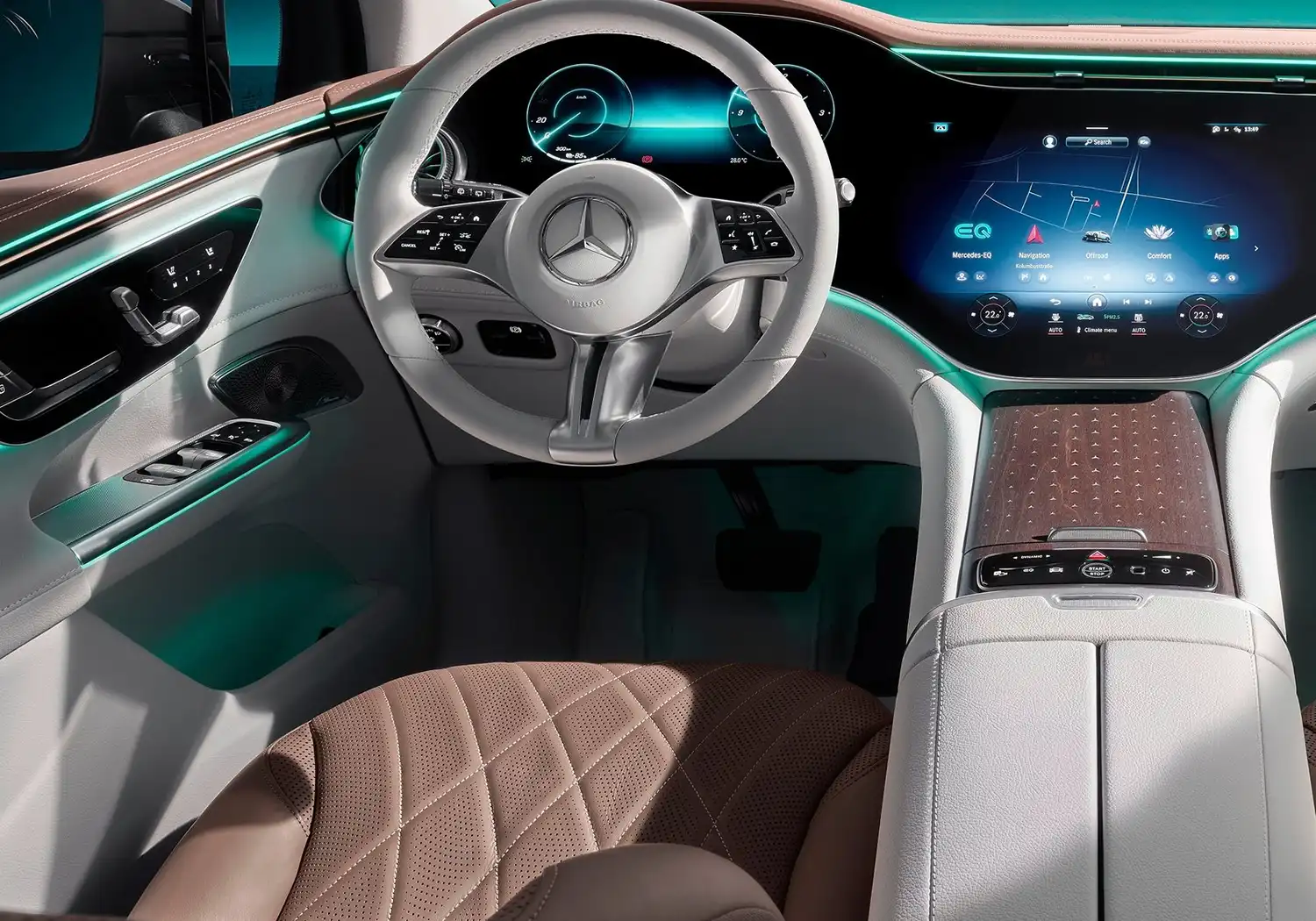
Heat pump as standard
The EQE SUV features a sophisticated thermal architecture with a heat pump as standard. This makes the system work very efficiently: the waste heat from the electric drive (inverter and electric motor) and also the high-voltage battery can be used to heat the interior. This reduces drastically the draw on battery power for the heating system, thus increasing the range. Another pleasant and efficient function is pre-entry climate control. The THERMATIC automatic climate control system with two climate zones is fitted as standard, while the THERMOTRONIC with four zones is available as an option.
New sound experience
“Serene Breeze” is the name of the new, fourth soundscape that makes its debut in the EQE SUV. It offers a relaxed and natural sound. With the holistic sound staging, the paradigm shift from combustion engine to electric car becomes audible for the occupants in the Mercedes-EQ models. A variety of soundscapes allows for an individual acoustic set-up. An optional interior driving sound is available. This adjusts adaptively to the driving style.
Tailor-made charging rates
Since June 2022, Mercedes me Charge has been offering three new charging tariffs in Europe that are tailored to individual driving performance. Mercedes me Charge S for occasional chargers, Mercedes me Charge M for normal chargers and Mercedes me Charge L for frequent chargers. With the introduction of the new, transparent tariff system, customers have access in part to fixed prices that apply regardless of the operator. With the Plug & Charge function, the EQE SUV can also be conveniently charged.
A host of high-tech features
DIGITAL LIGHT headlamp technology (special equipment) makes innovative functions possible, such as the projection of auxiliary markings or warning symbols onto the road. Another equipment highlight is ENERGIZING AIR CONTROL Plus. A HEPA (High Efficiency Particulate Air) filter cleans the incoming outside air at its very high filtration level. ENERGIZING COMFORT links together various comfort systems in the vehicle. The individual ENERGIZING COMFORT programmes enable a special feel-good programme depending on the mood or needs of the customer. This enhances physical comfort and performance while driving and during a break. The Dolby Atmos sound format takes the audio experience in the EQE SUV to a new level.
Distinctive purpose design
The proportions of the EQE SUV combine function and aesthetics with the sporty character of the SUV. The new model, with its unmistakable purpose design, marks a turning point in its class. The overhangs and the front-end assembly have been kept compact. The wheels in sizes from 19 to 22 inches are positioned flush with the outer edge of the body and lend a commanding stance.
A great deal of aerodynamic fine tuning
The EQE SUV shares some aerodynamic measures with its model brothers. The underbody with its numerous aerodynamic details plays a central role in a very good Cd value from 0.25, which was achieved despite the large load volume and short rear overhang. But the dimensional concept with the flat windscreen, sweeping roof line and indents were also important factors.
MBUX Hyperscreen and leather-free equipment available
The EQE SUV is based on the large electric platform from Mercedes-EQ. On top of this it boasts an interior that has been consistently digitalised. The optionally available MBUX Hyperscreen implements this vision to impressive effect. The standard Electric Art interior does not make use of any leather at all.
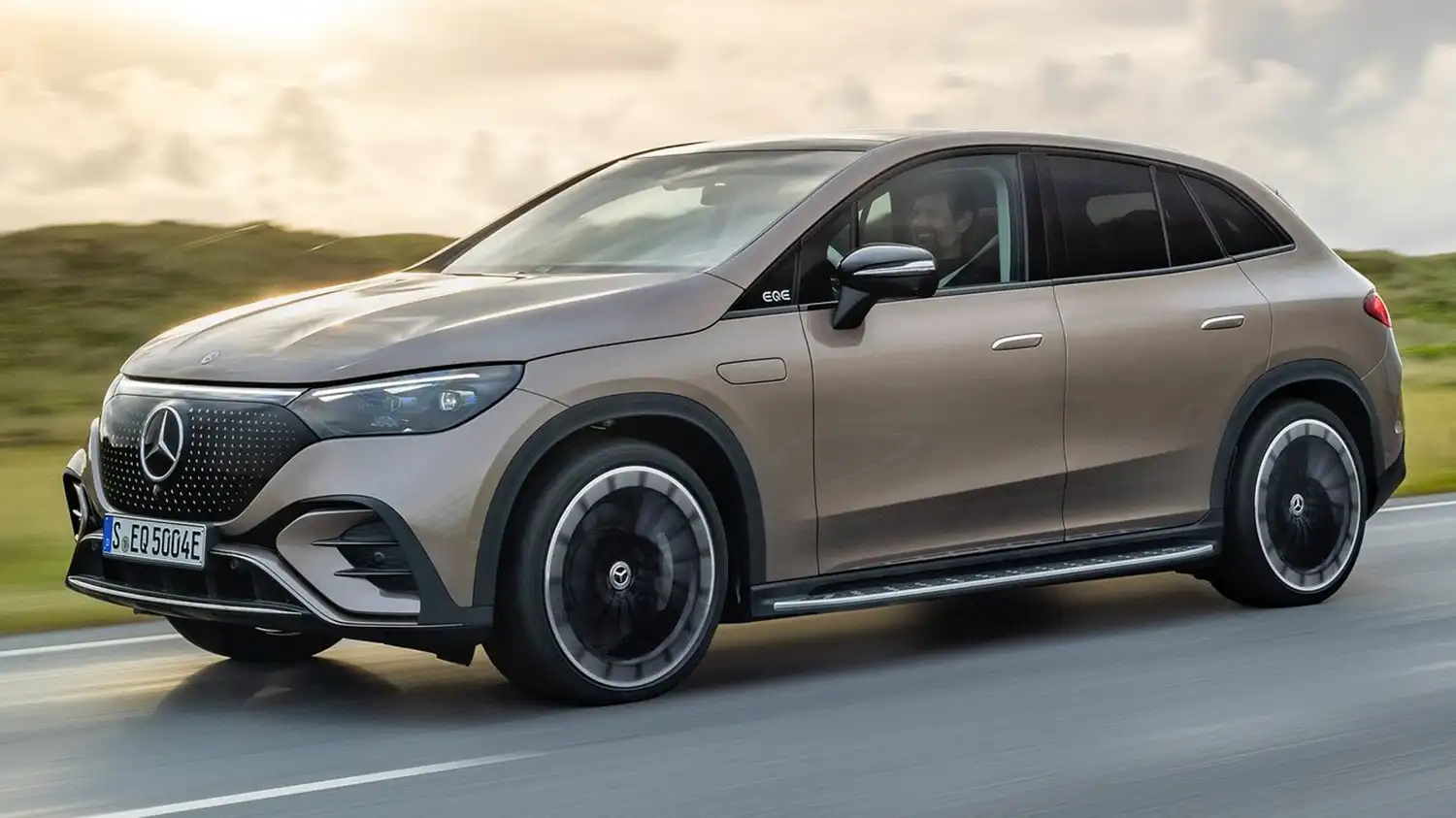
High level of passive safety
The principles of Integral Safety apply regardless of the type of drive system. Like all other Mercedes-Benz models, the EQS SUV therefore has a rigid passenger compartment, special deformation zones and state-of- the-art restraint systems. The European version of the EQE SUV can detect whether the rear seats are actually occupied. If a passenger in the rear is not wearing a seat belt, the driver receives a specific warning. The so- called occupant presence reminder can indicate children who may have been overlooked in the rear of the vehicle. In vehicles for Europe, Australia, New Zealand, USA and Canada, this system is on board as standard.
CO2-neutral production as part of the eco-balance
Production of the EQE SUV will start at the Mercedes-Benz plant in Tuscaloosa, Alabama (USA) in December. The battery factory in nearby Bibb County supplies the batteries for this model as well as for the EQS SUV. Since this year, all of Mercedes-Benz’s own passenger car and van plants worldwide have achieved CO2- neutral production as part of their eco-balance – including the two Mercedes-Benz plants in Alabama.
The new EQE SUV: the electric drive
The modular drive concept enables the EQE SUV to offer a wide range of maximum total outputs. Subject to final certification, Mercedes-Benz expects these to be in a similar range to the data for the EQE sedans. Depending on the vehicle equipment and configuration, WLTP ranges of more than 550 kilometres (342 miles) can be expected for European vehicles (with the exception of AMG models).
All EQE SUVs have an electric drivetrain (eATS) on the rear axle. The versions with 4MATIC also have an eATS on the front axle. In the 4MATIC models, the Torque Shift function ensures intelligent, continuously variable distribution of drive torque between the rear and front electric motors and thus the use of the most efficient eATS in each case. The modular drive concept enables high overall performance and a long range.
To further increase the range, the electric motor at the front axle can be completely decoupled. This step is undertaken by what is known as the Disconnect Unit (DCU). The intelligent disconnection system works complete automatically depending on the driving situation and the required output. At low loads, the DCU switches into 4×2 driving mode, and both the electric motor and the relevant transmission at the front axle cease operation. This ensures that the drag losses otherwise normally experienced are largely eliminated.
The electric motors on the front and rear axles are permanently excited synchronous motors (PSM). On a PSM, the rotor of the AC motor is fitted with permanent magnets and therefore does not need to be supplied with power. The magnets – and thus the rotor – follow the rotating alternating current field in the stator windings. In the EQE SUV, Mercedes-Benz uses a pull-in winding for a particularly strong magnetic field. The motor is referred to as synchronous because the rotor turns at the same rate as the magnetic field of the stator. The frequency is adjusted in the power electronics inverters to the speed requirements of the driver. The advantages of this design include high power density, high efficiency and high power constancy. The motor on the rear axle is very powerful due to the six-phase design: it has two windings with three phases each.
Cooling: sophisticated thermal concept for high load capacity
Consistently high performance and multiple accelerations without a drop in power characterize the drive philosophy of the EQE SUV. This includes a sophisticated thermal concept with some special features. What is known as a water lance in the shaft of the rotor cools it from the inside. Other cooling elements in the cooling circuit are fins on the stator, a needle-shaped pin-fin structure on the inverter and a transmission oil cooler. This also brings more efficiency during cold driving, because the heat exchanger then serves to heat the transmission oil and thus reduces friction in the transmission.
Intelligent energy recovery: one-pedal driving to a standstill
The EQE SUV offers several variants of energy recovery by means of recuperation. In this process, the high-voltage battery is charged by converting the mechanical rotary motion into electrical energy during overrun or braking mode. The driver can manually select the deceleration in overrun mode in three stages (D+, D, D-) as well as the coasting function via shift paddles behind the steering wheel. Also available: DAuto.
ECO Assist also offers situation-optimized recuperation; deceleration is so strong or weak that it ultimately results in the most efficient driving style. Recuperative deceleration is also used as far as possible for vehicles detected ahead until they come to a standstill, for example at traffic lights. The driver does not need to press the brake pedal for this; literally one-pedal driving.
Noise and vibration comfort: comprehensive measures
Even the design of the electric drivetrains (eATS) takes into account noise and vibration comfort, or NVH for short (Noise, Vibration, Harshness). The magnets are arranged inside the rotors in an NVH-optimized way (known as ‘lamination’). This also reduces the use of rare earths. The shape of the winding, the stator tilt, also causes less vibration, especially at low speeds. The coils in the stator are at an angle in relation to the permanent magnets of the rotor. Otherwise, what is known as cogging torque could occur, they would lead to slight but unpleasant vibrations when driving very slowly.
In addition, the eATS have a special foam mat all around as an NVH cover. The inverter cover has a sandwich construction of three metal and plastic layers. The eATS are doubly decoupled from the body via elastomer bearings: at the front axle opposite a supporting frame and this against the body, at the rear axle with a subframe.
Highly effective spring/mass components provide continuous sound insulation from the cross member under the windshield to the floor of the load compartment. Acoustic foams are inserted into many members during construction of the bodyshell.
The electric refrigerant compressor has an NVH cover as encapsulation. In the rear-wheel-drive EQE SUVs it is also soft-suspended, while in the 4MATIC models it is bolted directly to the front eATS. The operating strategy of the refrigerant compressor also contributes to the low noise level of the vehicle. Certain rpm ranges at which disturbing resonances may be audible when stationary or in a traffic jam are avoided or quickly passed through.
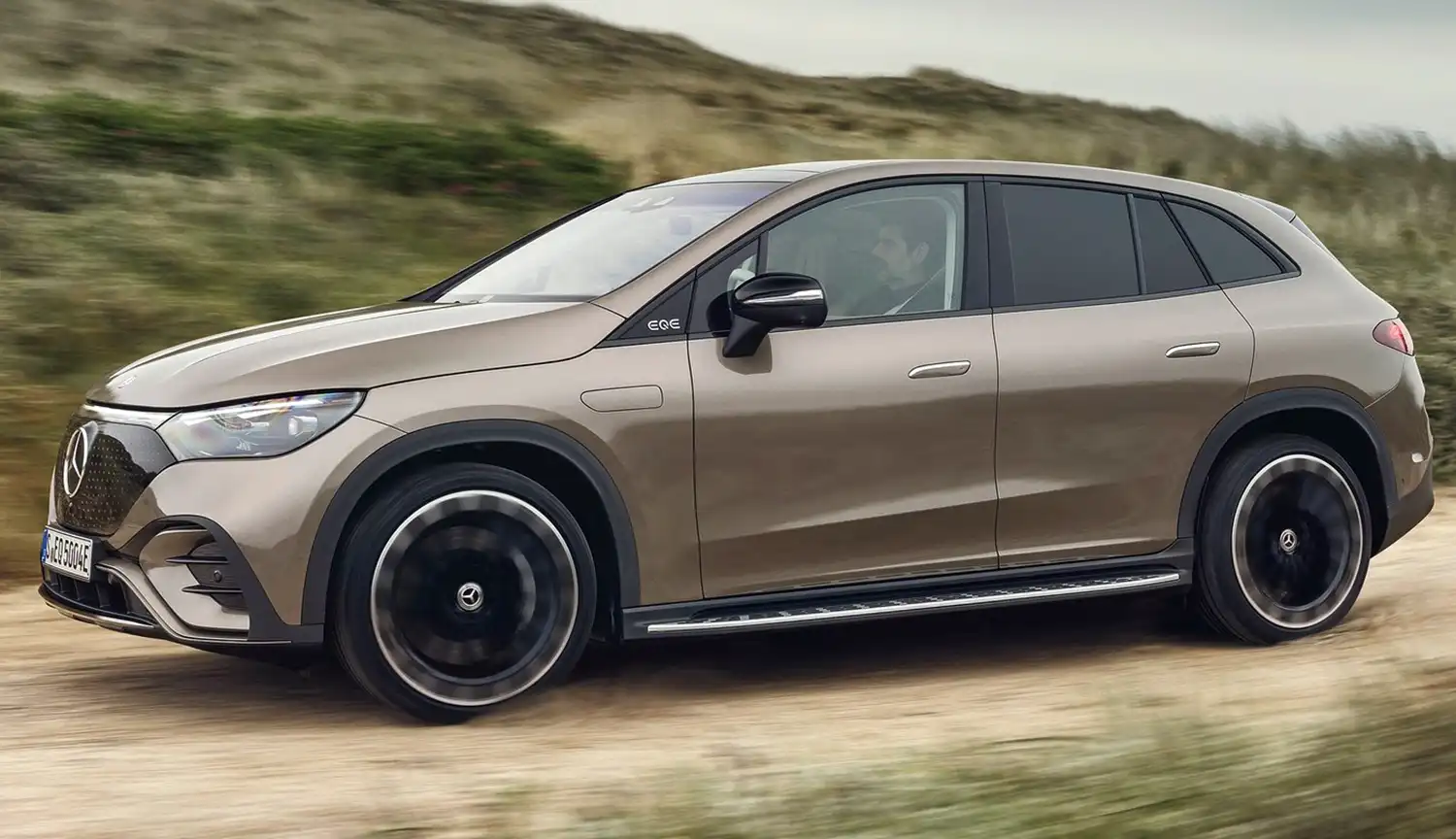
Charging components and functions: always connected
A latest-generation charging system sits above the rear axle of the EQE SUV. It can be used to charge the battery with a charging capacity of up to 9.6 kW. In addition, intelligent wallboxes from national partners are available to customers in the individual markets. Mercedes-Benz also has a partnership to provide an installation service for these wallboxes. This includes a preliminary check of the installation conditions, detailed advice and installation.
A DC fast charging system with a charging capacity of up to 170 kW is fitted on board for fast charging via direct current. High charging currents can be maintained for a long time through temperature and charging management.
Three charging programs are offered in the EQE SUV – Standard, Home and Work. In these, parameters such as departure time, air conditioning and maximum charge level can be preset. The Home and Work charging programs can be activated based on location. This means that they are switched on automatically as soon as the vehicle is parked at a charging point at the positions stored in the system. The user is informed about this in MBUX. The EQE SUV also features the intelligent charging functions of ECO Charging and charging interruptions. In Japan, the EQE SUV will also enable bidirectional charging, i.e. a flow of electricity in both directions (“smart grid”).
The new EQE SUV: the traction battery
The scalability of the battery system in the new Mercedes-EQ models in the luxury and premium class enables different range and performance variants. In the EQE SUV, the lithium-ion battery consists of ten modules. Subject to final certification, Mercedes-Benz expects usable capacity to be in a similar range as the EQE sedan data. The innovative battery management software, which was developed in-house, allows updates over the air (OTA). In this way, the energy management of the EQE SUV remains up-to-date throughout its entire service life.
Battery development is a decisive factor in Mercedes-Benz’s electrification strategy. After all, the battery is the heart of an electric car and makes a decisive contribution to, among other things, the range and thus the driving characteristics of the electric vehicle. With the EQS, a new generation of batteries with significantly higher energy density has been launched, from which the EQE SUV now also benefits. The new batteries set standards in terms of performance, efficiency and charging capacity.
They also meet the high Mercedes requirements in terms of safety, durability and sustainability. Mercedes-Benz issues a battery warranty for its high-voltage batteries, and thus a performance guarantee to customers: 10 years or a mileage of 155,000 miles with a defined residual capacity.
Comprehensive battery expertise
A team of experts at the Mercedes-Benz Battery Competence Center developed the highly efficient batteries entirely in-house. The software of the intelligent control system was also developed and programmed in the company.
A lithium-ion battery with ten cell modules is installed in the EQE SUV. This generation of batteries takes a big step towards the sustainability of cell chemistry: the optimized active material consists of nickel, cobalt and manganese in a ratio of 8:1:1. This has reduced the cobalt content to less than ten percent. The continuous optimization of the recyclability is part of Mercedes-Benz’s holistic battery strategy. The aim is to be able to dispense entirely with materials such as cobalt through the use of innovative post-lithium-ion technologies.
Intelligent operating strategy
The battery is integrated into the EQE SUV’s intelligent thermal management system with heat pump as standard. If the intelligent Navigation with Electric Intelligence is activated, the battery is preheated or cooled as needed while driving. As a result, the temperature at the charging point is in an optimal range for efficient charging. The desired temperature range of the battery is achieved with the aid of the cooling circuit and a PTC (Positive Temperature Coefficient) booster heater integrated into it.
The new EQE SUV: the suspension
The chassis of the new EQE SUV comprises a four-link suspension at the front and an independent multi-link suspension at the rear. Due to the comparatively short wheelbase of 119.3 inches and the corresponding suspension tuning, it feels particularly agile and maneuverable even with the basic set-up. The AIRMATIC air suspension with ADS+ continuously adjustable damping is available as an optional extra. To increase ground clearance, the vehicle level can be raised by up to 1 inch. In addition to the DYNAMIC SELECT programs of ECO, COMFORT, SPORT and INDIVIDUAL, the EQE SUV models with 4MATIC offer the additional OFFROAD program for off-road driving. A rear axle steering system with a steering angle of up to 10 degrees is also available as an option for great maneuverability and agility.
The optional AIRMATIC air suspension responds in a particularly perceptive way. It combines air suspension bellows with adaptive ADS+ dampers whose characteristics can be varied at each individual wheel, fully automatically, in both the compression and rebound stages. While driving, a sophisticated sensor system and algorithms set the dampers according to the quality of the road to ensure that, for example, driving over a bump with just one wheel is not transmitted to the entire axle and the interior. Spring and damper are combined in one strut on the front axle.
This level control is part of AIRMATIC. It keeps the ground clearance constant irrespective of the vehicle load, but also makes changes when needed. To increase ground clearance, the vehicle level can be raised by up to 1 inch. This is possible up to a speed of 50 mph. The body can be raised by 1 inch at the touch of a button below 37 mph. Above 43 mph it is automatically lowered back to normal level. Furthermore, in the COMFORT and SPORT programs, the body is automatically lowered by 0.4 and 0.8 inches, respectively, at speeds above 75 mph to reduce wind resistance and increase driving stability. If the vehicle drops below 50 mph, the body level returns to the initial position.
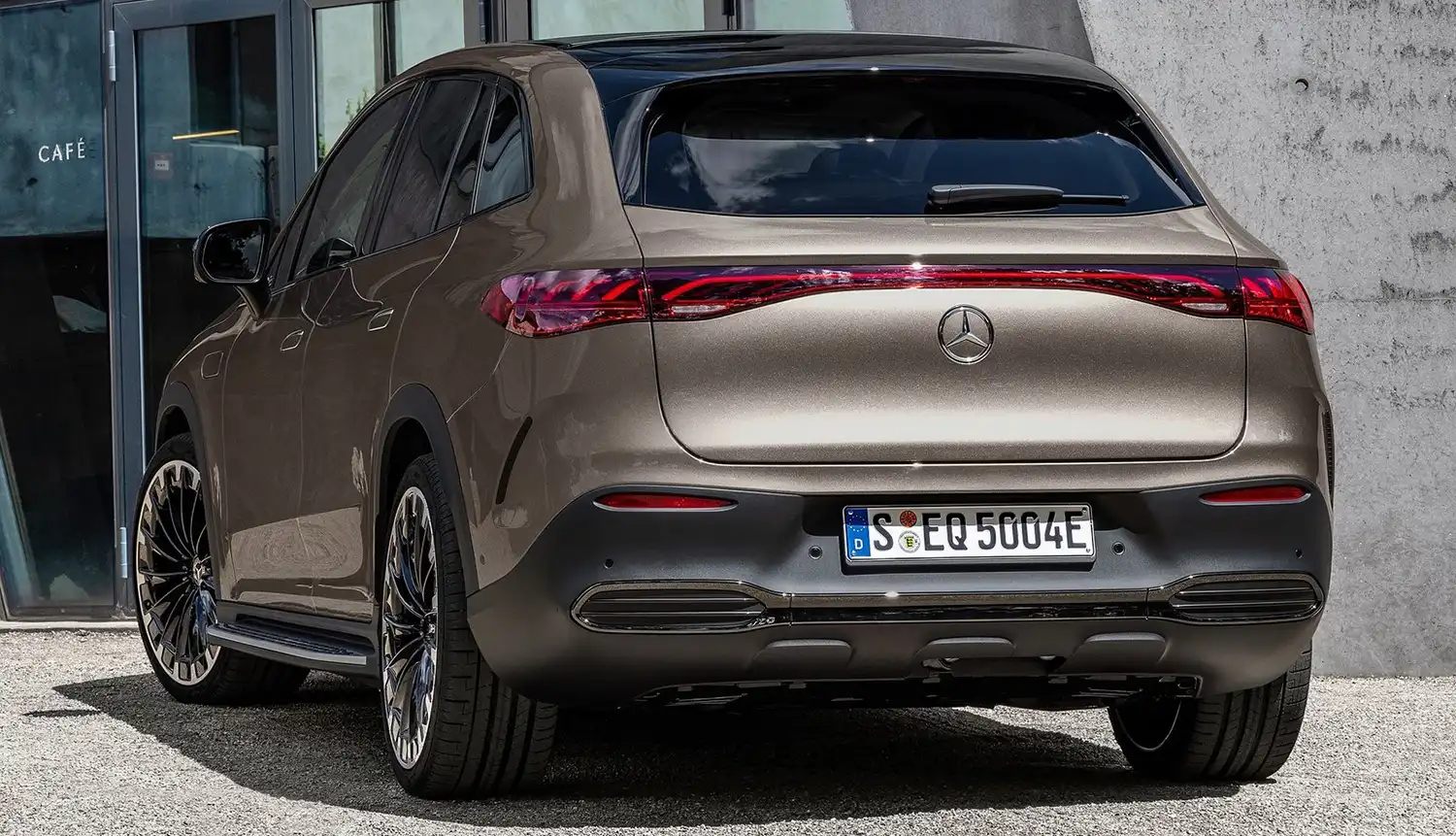
As maneuverable as a compact car: both axles can do the steering
Thanks to rear axle steering (optional extra), the EQE feels as maneuverable as a compact car in the city. The steering angle at the rear axle is up to ten degrees. The turning circle is reduced from 40.4 to 34.4 feet with rear axle steering.
The interaction between the front axle and rear axle steering was designed so that the steering offers agile response and requires little effort when driving in the city and on country roads. At the same time, a very high level of stability is achieved. This results in small side-slip angles and a high level of yaw suppression. At high speeds, the focus is more on stability, though without compromising precision and responsiveness. This added value is achieved by the integrated actuation of steering and brakes (ESP®), and considerably improves driving safety as a result.
DYNAMIC SELECT: with off-road drive program
The driver can change the characteristics of the drive, ESP®, suspension and steering using DYNAMIC SELECT. In addition to ECO, COMFORT, SPORT and INDIVIDUAL, the 4MATIC versions of the EQS SUV feature OFFROAD, a further mode for off-road driving. Overall, the accelerator pedal curve is much flatter. When equipped with AIRMATIC, the vehicle level is raised by 1 inch. At speeds above 43 mph, the vehicle lowers to normal level. If the speed falls below 31 mph, the vehicle is raised again. Two versions of the OFFROAD driving mode with and without ESP® can be selected:
In the OFFROAD driving mode with activated ESP®, little slip is permitted on the potentially spinning wheels. With this, significantly fewer tracks are left behind on, for example, wet grass. This is achieved through torque balancing between eATS and ESP®. The pressure in the control system thus matches the torque at the wheel exactly. When articulated in the terrain, a kind of pre-filling takes place. This means that the unloaded wheel is already supplied with pressure in the wheel brake during the rebound phase in order to prevent it from spinning.
The aim of the OFFROAD drive program with ESP® OFF is to allow sufficient slip, but still make the vehicle safely controllable. A lot of wheel slip, for example, is helpful to have enough propulsion on sand – the vehicle burrows forward. The control thresholds of the ASR traction control system are significantly widened here. Even in potentially critical situations, such as turning around on a dune, when the momentum is not enough to reach the top, the driver always has full torque available. Power is sufficiently available from the eATS.
The off-road ABS works with significantly more slip. The slip is reduced via the steering angle so that the vehicle remains steerable. Downhill Speed Regulation (DRS) is now realized via the iBooster and not via a hydraulic unit (ESP®), as the models with combustion engine. As a result, DRS now controls much more quietly and even more smoothly.
The default setting is the COMFORT driving mode. The selection is acknowledged by audible and visual feedback. The desired driving mode is shown as the status and depicted on the central display.
The new EQE SUV: aerodynamics
After the EQS Sedan, EQE Sedan and EQS SUV, the EQE SUV is already the fourth Mercedes-EQ to be based on the modular architecture for large electric vehicles. The EQE SUV shares some aerodynamic measures with its model family. The underbody with its numerous aerodynamic details plays a central role in a very good Cd value, which was achieved despite the large load volume and short rear overhang. But the dimensional concept with the flat windshield, sweeping roof line and indents were also important factors.
Many aerodynamic measures result in the high aerodynamic efficiency of the EQE SUV. These include novel, patent-pending wheel spoilers in front of the front axle. With a serrated lower edge, small bumper and longitudinal ribs, numerous details contribute to improving the flow of air to the front wheel.
Special aero-claddings were developed for the aerodynamically optimized wheels. Depending on the equipment, these wheel trims mean an improvement of up to two Cd points compared with an aero-wheel without inserts. The optionally available running board drops down in the non-visible area on the underside. This has a positive influence on the airflow to the rear wheels and results in a measurable aerodynamic advantage.
Wheel spoilers also sit in front of the rear axle which have a bumper on the inside. Special cladding spoilers in the area of the rear side wall have a very large influence on the aerodynamic performance. They direct the airflow around the rear wheels. Depending on the rim size, the cladding spoilers on the EQE SUV are installed in two lengths.
The underbody paneling has striking details such as the jagged turbulators in the front section. They prevent displacement of the underbody airflow. The flow is directed downwards from the wheel arches. In addition, the underbody paneling on the EQE SUV has been supplemented with a thrust arm covering and a spring link covering. The latter is designed with a slope that directs the airflow from the battery to the diffuser. The diffuser angle of the rear diffuser has been optimized in the wind tunnel.
The side spoilers and roof spoiler on top of the rear moves the end of the roof edge back. In combination with the stronger constriction, this offers aerodynamic advantages. Even the tail lights have an integrated edge that functions as a spoiler. These details result in an aerodynamically advantageous rear end with sharp airflow break-away edges.
The following is an overview of the details of the aerodynamic development:
- Aerodynamically favorable dimensional concept
- Aerodynamically optimized wheels in all sizes, in the 19-inch entry size with aero-claddings, and equally aerodynamically optimized tires with improved geometry
- Cooling air control system
- Continuous seals in the front area, i.e. between service flap, black panel, headlamps and light strip
- Streamlined design of the A-pillar and water trap for better visibility of the outside mirrors even in adverse weather conditions
- Wheel spoilers at front and rear
- Special cladding spoilers in the rear side wall in front of the wheels
- Spoiler integrated into tail lights
- Side spoilers and roof spoiler at the top of the rear end
- Extensive underbody paneling
Extensive sealing and insulation measures reduce wind noise
In an electric car without the usual level of drive noise, occupants often perceive wind noise more clearly. That’s why the aeroacoustic behavior is particularly important. Lots of fine-tuning in the details: in order to reduce or prevent low-frequency noises that can be perceived as reducing comfort, numerous cavities in the car body were filled with acoustically effective foam, for example.
The high-frequency components of wind noise have also been reduced in the EQE SUV through improved seals on the windshield mount and on the outside mirrors. The aeroacousticians paid special attention to the seals of the transitions between the five side windows.
The optional Acoustic Comfort Package further enhances noise comfort. This includes acoustically effective laminated glass on the windshield and the side windows of the driver and passenger doors. On the panoramic roof, various wind deflectors, covers and seals with improved geometry ensure low noise levels despite the large roof opening.
The new EQE SUV: the interior design
The EQE SUV is based on the large electric platform from Mercedes-EQ. On top of this it boasts an interior that has been consistently digitalized.
The standard center console incorporates a soft armrest in the rear section. It is first visually interrupted before being transitioned into the floating central display. The smooth transition from 3D in the center console compartment to 2D on the touchscreen is seamless, i.e. without interrupting the glass-look design.
The Electric Art equipment line includes luxury seats with lavishly crafted covers. The comfort-oriented seats meet high demands with form-following, customized perforations in different layouts.
The vent band from the cockpit is visually continued in the front doors. A floating control cluster with integrated door opener and seat controls takes over the functional interpretation of formerly purely decorative elements. The door center panel develops in a sensual, dynamic movement from the vertical surface into the horizontal and thus integrates the armrest seamlessly. The front section of the armrest is designed as a metallic high-tech element that can be used as a free-floating grab and pull handle and contains the power window switch. In the dark, this floating, avant-garde aesthetic is particularly impressive thanks to an ambient light corona.
A special welcome & goodbye scenario has been developed for the Mercedes-EQ models, which is also coordinated with the ambient lighting.
Color & trim: avant-garde and tradition for a special ambience
Avant-garde, as well as traditional materials and colors, give the interior a special atmosphere. The modern, delicate NEOTEX structure combines the look of nubuck leather and high-tech neoprene. It can be found on the instrument panel and the armrest.
Five coordinated color combinations in the interior emphasize the generous sense of space. The EQE SUV is immersed in a progressive and luxurious color scheme of warm and cool tones that emphasize the sculptural and sensual design. For example, warm, modern sable brown is combined with techy-looking neva grey and biscaya blue/black. The color rose gold, derived and evolved from the electric coil, emphasizes the design of the vent band and is used as a contrasting color.
The innovative trim parts make a key contribution to the aesthetics in the EQE. A hybrid trim element brings together the warmth of wood with the technical coolness of real aluminum. The trim in an anthracite 3D relief-look finish, on the other hand, features fine metal pigments. The laser-cut trim element backlit with the Mercedes-Benz pattern also creates a special ambience. The star pattern is lasered into the plastic trim and is adaptively backlit.
UX design: multiple display styles and modes to choose from
The functional content and the operating structure are adapted to electric driving. Visually, all graphics are designed in a new color scheme of blue/orange throughout. The classic cockpit display of the two round dials has been reinterpreted with a digital light sabre in a glass lens. All content relevant to driving can be accessed between the round dials.
The appearance of the screens can be individualized with three display styles (Understated, Sport, Classic) and three modes (Navigation, Assistance, Service).
The new EQE SUV: passive safety
The principles of Integral Safety apply regardless of the type of drive system. Like all other Mercedes-Benz models, the EQE SUV therefore has a rigid passenger cell, special deformation zones and modern restraint systems. The EQE SUV can detect whether the rear seats are actually occupied. If a passenger in the rear is not wearing a seat belt, the driver receives a specific warning. The occupant presence reminder can indicate children who may have been overlooked in the rear of the vehicle. In vehicles for Europe, Australia, New Zealand, USA and Canada, this system is on board as standard.
The fact that the EQE SUV is based on an all-electric architecture also opened up new design possibilities for its safety concept. This made it possible to select the appropriate installation space for the battery in a crash-protected area in the underbody. And because there is no large engine block on board, the behavior in a frontal crash could be modeled even better. In addition to the standard crash tests, the car’s performance in various additional load situations was verified and extensive component tests carried out at the Vehicle Safety Technology Centre (TFS). The particular focal points in an SUV include partner protection and roof strength.
Safety structure: Accident protection is not a question of the powertrain concept
The bodyshell of the EQE SUV is largely made of different types of steel. Reinforcements made of high-strength steel are used in the main floor. Press-hardened steel reinforcements are intelligently integrated in the bodyshell structure and combined with high-strength, hot-formed steel components. The hot-formed steels in the A and B-pillars are partially annealed in the flange areas, i.e. they feature special thermal after treatment there. In the event of a crash, this can prevent the formation of cracks. This is how the strict Mercedes-Benz crash requirements are achieved.
Frontal impact
To ensure that the front end of the EQE SUV absorbs the energy as evenly as possible, a large crossmember connects the two longitudinal members. As in every Mercedes-Benz, the cross connection not only serves as self-protection, but is also a key component for the protection of other road users. Deformable crash boxes connect to the crossmembers, making it easier to repair minor damage.
In the event of a severe frontal impact, two longitudinal members made of high-strength steel absorb the main energy, depending on the accident scenario. A supporting role is played by an upper load path on the shock-absorber strut tower and a lower load path along the integral carrier. The integral carrier made of steel not only accommodates the eATS components, axle components and the steering gear, but also plays this key role in the event of a crash. In the event of more severe deformations, the wheels form an additional load path, whereby they are able to move towards the rear and be braced against the sill and/or sidewall. The geometry and strength of the sills have been designed for this accordingly. Honeycomb deformation elements are installed between the integral support and the battery housing, which can limit the force on the battery housing. The battery housing itself is extremely rigid and allows for relatively little deformation, so that the cells inside are not damaged. Reinforcing structural components have been additionally integrated into the front area of the underbody with minimal overlap for the load case.
Side impact
In principle, in a side impact, only a very small deformation path is available. High-strength structures in the EQE SUV therefore serve to protect the occupants, but also the battery. Alongside the doors with their reinforcements, the sidewall structure also comprises the pillars, the side roof frame and the side members/sills. Cross reinforcements in the underbody, as well as the very rigid battery housing, contribute to the high stability in a side impact. The sills are made of steel and feature a shell design, with an additional aluminum profile inserted. For a side impact, the sills are specifically designed to be deformable in order to avoid critical damage to battery modules as far as possible.
Rear impact
The EQE SUV is also equipped for rear impacts. As with the front-end assembly, a cross-member with bolted-on crash boxes helps to distribute the impact energy from a one-sided load to both longitudinal members. Thanks to the specific design of the structural components and the rear axle carrier, the requirements on battery safety have also been fulfilled.
Rollover
In the event of a rollover, it is particularly important that sufficient headroom is maintained and that measures are taken to prevent heads from possibly swinging out. At Mercedes-Benz, strict survival space requirements apply worldwide as part of its Real-Life Safety philosophy. For the EQE SUV, these were validated by roof-drop tests and roof indentation tests, among others. This means that even the strict requirements of the IIHS (Insurance Institute for Highway Safety) for roof indentation resistance can be met. In these tests, a pressure plate is applied to the roof structure on the A-pillar above the windshield on the driver’s side and then on the passenger’s side. The vehicle roof must withstand a compressive force that can reach up to four times the vehicle weight.
High-voltage system: automatic shutoff in the event of serious accidents
The battery, high-voltage (HV) cables and other HV components have been designed and protected in such a way that they meet Mercedes-Benz’s high safety requirements in the event of an accident.
The multi-stage protection concept of the high-voltage (HV) system has already proven itself in the other Mercedes-EQ models. In case of danger, it can be automatically switched off and disconnected from the battery. A distinction is made between a reversible and an irreversible shutoff. A reversible shutoff can take place in the event of minor frontal collisions. Afterwards, it is possible to reconnect the high-voltage system by pressing the start button again.
If the vehicle does not detect a fault during the system check with insulation measurement initiated by this, the EQE SUV therefore remains maneuverable. Only in the event of severe frontal collisions, in which the vehicle is usually no longer drivable anyway, is the high-voltage system irreversibly switched off. It can no longer be activated without repair. This also applies to collisions from the side and in rollovers when restraint systems are triggered. The HV system is also irreversibly switched off in the event of a severe rear-end collision. When shutting down, there is a provision to ensure that within a few seconds, there is no residual voltage in the high-voltage system outside the battery that could cause injury.
In addition, disconnection points are also provided for the rescue forces, where they can deactivate the high-voltage system themselves.
A special feature is that the sensor system of the airbag control unit remains active even during the charging process. If an impact of a certain severity is detected while the vehicle is connected to a charging station, the EQE SUV can automatically interrupt the charging process.
Acoustic ambient protection: special sound as a warning for pedestrians
The acoustic ambient protection (standard) is an artificially generated vehicle noise. This makes it easier for pedestrians to perceive the EQE SUV at low speeds. One sound generator each is located in weatherproof locations in the front and at the rear in the underbody. An EQ-specific sound is generated up to a vehicle speed of approx. 18 mph. Initially it becomes louder and higher with increasing speed. This change allows conclusions to be drawn about the driving status (braking/acceleration).
Above 12 mph, the volume is then already gradually reduced, since the vehicle can then be perceived by its tire and wind noise. If the speed drops from a higher speed back down to 18 mph, the sound is faded in again. When reversing, an intuitively recognizable interval tone sounds regardless of the speed.
Sophisticated restraint systems
In addition to driver and front passenger airbags, a knee airbag on the driver’s side is also standard. It can protect the legs from contact with the steering column or instrument panel in a severe frontal crash. This is to prevent or mitigate injuries.
The standard window airbags can reduce the risk of head impact with the side window or penetrating objects. In the event of a serious side-on collision, the window airbag on the side of the impact extends from the A- to the C-pillar like a curtain over the front and rear side windows. If a rollover is detected, the window airbags can be activated on both sides.
Pyrotechnic belt tensioners and force limiters are standard on all outer seats. There are optional side airbags for the second row of seats. They cover the chest area of the occupants in the outer rear seats in the event of a severe side impact and can therefore supplement the protection provided by the standard window airbags.
The EQE SUV has i-Size child seat attachments as standard on the two outer seats in the second row. With two anchors each between the seat backrest and the seat cushion, corresponding child seats are installed particularly quickly and securely. Top-tether attachment points on the rear of the rear seat backrests provide additional support.
Warnings: if children and animals are overlooked
The occupant presence reminder can help to indicate children or animals that may have been overlooked in the rear of the vehicle. It activates and deactivates automatically if it can be assumed, for example, that small children could get in or out by opening a rear door for a longer period of time.
When the vehicle is switched off, the driver receives the text message “Do not leave persons or animals behind” on the driver’s display if the system has activated automatically beforehand. The customer has the option to deactivate the system. An indicator light shows the status of the system.
PRE-SAFE® system precautionary protection as standard
The PRE-SAFE® preventive occupant protection system comes as standard in the EQE SUV. Together with the familiar precautionary measures in the event of a potential frontal and rear-end crash, PRE-SAFE® Impulse Side (available in conjunction with the Driving Assistance Plus Package) forms a kind of virtual crumple zone that extends around the vehicle.
As there is only a limited crumple zone available in a severe side impact, PRE-SAFE® Impulse Side can move the affected driver or front passenger away from the danger towards the center of the vehicle even before the crash as soon as the system detects an impending side collision. For this purpose, air chambers in the side bolsters of the front seat backrest are inflated in fractions of a second.
The new EQE SUV: production
Production of the EQS SUV started at the Mercedes-Benz plant in Tuscaloosa (USA) at the end of August, followed just a few months later by the start of production of the new EQE SUV. The battery factory in nearby Bibb County supplies the batteries for the two SUV models from Mercedes-EQ. As of this year, all of Mercedes-Benz’s own passenger car and van plants worldwide have achieved CO2-neutral production as part of their eco-balance – including the two Mercedes-Benz plants in Alabama.
The Mercedes-Benz plant in Tuscaloosa, Alabama, has been the production site for large SUVs bearing the three-pointed star since 1997. Mercedes-Benz will soon also exclusively produce the all-electric EQE SUV at the North American plant. The EQE SUV will be integrated into the ongoing series production at the Mercedes-Benz Tuscaloosa plant. The highly flexible production system of Mercedes-Benz makes it possible to assemble different models and powertrains on a single production line. This is evident in what is known as the “wedding station”, for example, where bodywork and powertrain come together. This “full-flex wedding” comprises several modular stations that allow joining different powertrain variants with the respective vehicle bodies on the same assembly line. For example, the EQS SUV is produced on the same line as the conventionally powered SUVs, allowing the plant to adapt quickly to changes in customer demand.
Local battery production is a key success factor for Mercedes-Benz’s electrification initiative. The battery factory in nearby Bibb County, which opened in March 2022, produces the battery systems for the EQE SUV on an approximately 984-foot-long production line with more than 70 work stations. In a fully digitalized production process, a large number of components are assembled into a complete system, including the cell modules and the EE compartment for the intelligent integration of the power electronics. The battery of the EQE SUV is based on a modular architecture that is also used in EQS, EQS SUV and EQE. When running at full capacity, up to 600 employees in two-shift operation produce batteries in the six digits annually.
Thanks to comprehensive digitization with the MO360 production ecosystem and the consistent application of Industry 4.0 technologies, the Tuscaloosa and Bibb County plants operate flexibly and highly efficiently. MO360 obtains real-time information from the most important production processes and IT systems of the approximately 30 Mercedes-Benz passenger car plants worldwide, and integrates important software applications.
Mercedes-Benz has invested more than seven billion dollars overall in Alabama since the 1990s. This includes one billion dollars in the construction of the new battery factory in Bibb County, in the logistics center and in the flexibilization of the production sites. At present, Mercedes-Benz U.S. International (MBUSI) employs a workforce of about 4500 and in addition secures some 11,000 more jobs at suppliers and service providers in the region. Since 1997, about four million vehicles rolled off the assembly line at the plant in Tuscaloosa. In 2021 alone, it was some 260,000 SUVs. About two thirds of the annual production output is exported, making MBUSI one of the biggest vehicle exporters in the USA
Mercedes-AMG EQE SUV
Mercedes-AMG presents the EQE SUV, a further milestone in its electrification strategy – the first all-electric SUV from the performance and sports car brand. With its variable interior and performance-oriented drive concept, it is the most versatile electric vehicle in the Mercedes-AMG portfolio. The new model also offers generous space for passengers and luggage. Like the AMG EQS Saloon and AMG EQE Saloon, the AMG EQE SUV is based on the electric platform from Mercedes-EQ. Two powerful electric motors and the fully variable all-wheel drive form the basis for the hallmark AMG dynamic driving experience. The Mercedes-AMG developers have also designed many other parameters independently. These include the AMG RIDE CONTROL+ air suspension with Adaptive Damping System, rear-axle steering and AMG ACTIVE RIDE CONTROL – an AMG-specific roll stabilisation system. Added to this are the AMG SOUND EXPERIENCE and the exterior and interior design. Two variants of the new performance SUV are available: The entry-level Mercedes-AMG EQE 43 4MATIC (provisional WLTP combined power consumption: 25.1-22.0 kWh/100 km; provisional WLTP CO2 emissions: 0g/km)[1] and the even sportier Mercedes-AMG EQE 53 4MATIC+ (provisional WLTP combined power consumption: 27.8-22.6 kWh/100 km; provisional WLTP CO2 emissions: 0 g/km)1.
“The AMG EQE SUV is another milestone in our Future of Driving Performance. The new model is our first all‑electric SUV. And, after the AMG EQS and AMG EQE Saloon models, this is already the third performance model that we have realised as a derivative on the Mercedes-EQ electric platform. With its variable interior and high-performance all-wheel drive, it is Mercedes-AMG’s most versatile electric vehicle. A real all-rounder – a real AMG!” says Philipp Schiemer, CEO of Mercedes-AMG GmbH.
“The compact format of the EQE SUV, the short wheelbase and the performance-oriented drive concept form the perfect starting point for realising an agile, highly emotional and luxurious driving experience with our AMG-specific solutions. This particularly applies to the drive system, suspension, brakes and sound. It ensures that our customers can look forward to the Driving Performance that is a hallmark of our brand,” says Jochen Hermann, Chief Technical Officer of Mercedes-AMG GmbH.
Exterior design with characteristic AMG features
The exterior design is characterised by generously modelled surfaces, reduced joints and seamless transitions. Dynamic proportions emphasise the sporty character. Many AMG characteristic features guarantee a high recognition value and help strengthen the brand. These include the AMG-specific black panel radiator grille with hot-stamped vertical struts in chrome, integrated Mercedes star and “AMG” lettering. A new feature is the brand-specific badge on the bonnet with the AMG emblem instead of the Mercedes star: It now also adorns a purely electric vehicle from Mercedes-AMG for the first time. Another front-end feature is the AMG-specific front apron, painted in the body colour with A-wing in high-gloss black and a chrome trim. The same look characterises the front splitter in high-gloss black with chrome trim and flics and fins on the simulated air inlets. The air diffusers in high-gloss black on the left and right allow the AIR CURTAIN effect, which guides the air around the front wheels in a streamlined manner. The standard DIGITAL LIGHT headlamps feature a specific AMG projection when opening and closing the vehicle.
In the side view, AMG-specific wheel arch claddings in the body colour and the seamlessly integrated, fully recessed door handles add visual accents. Added to this are aerodynamically optimised 21 or 22-inch AMG light-alloy wheels. The rear apron in the body colour with aerodynamically optimised diffuser and longitudinal fins as well as the tail lights in a helix design round off the dynamic appearance.
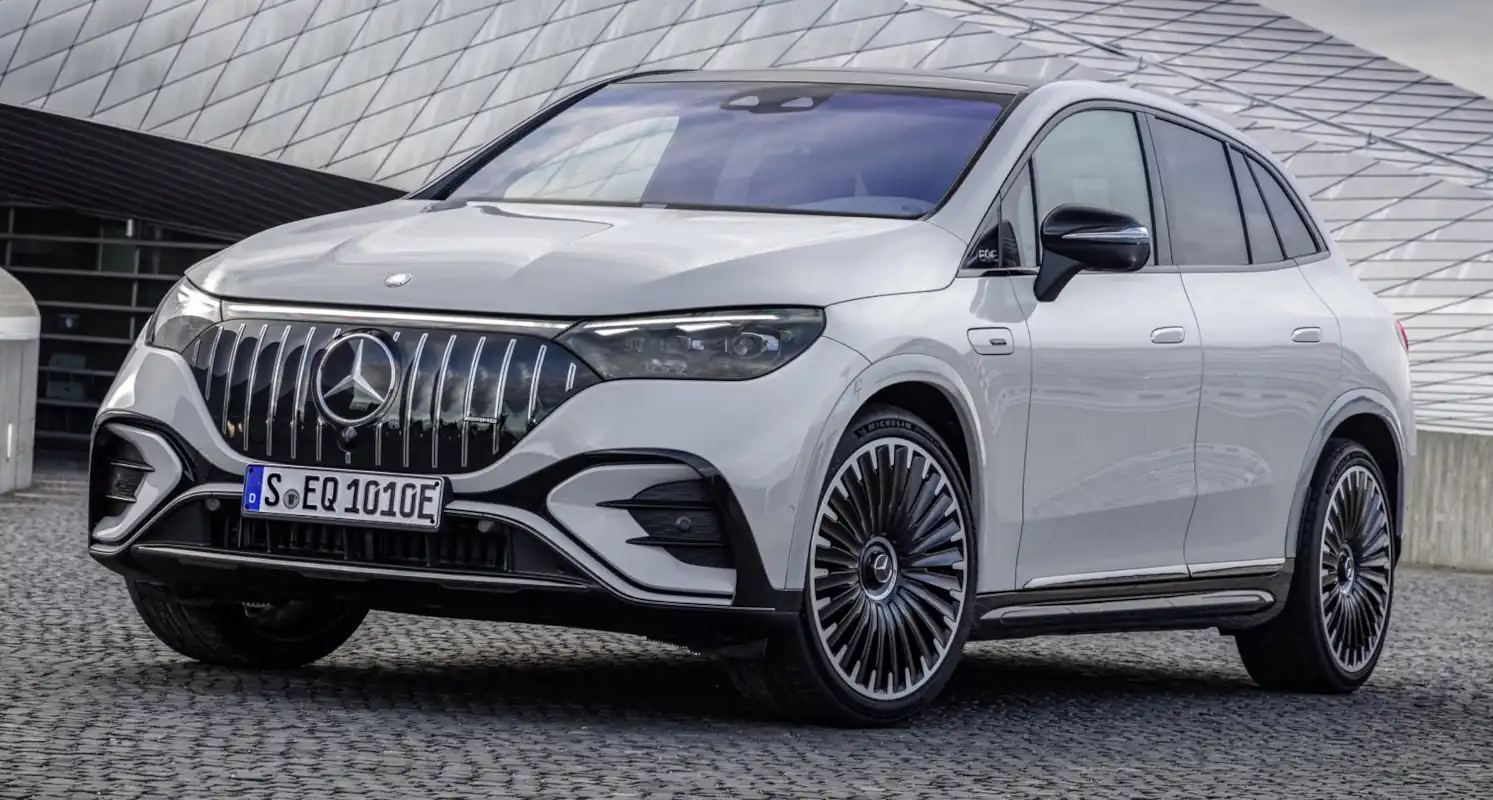
Interior design with a particularly sporty touch
The interior is also dominated by style-defining AMG features. Here, the new models offer a sporty ambience including seats with individual graphics and special seat covers in ARTICO man-made leather with MICROCUT microfibre and red topstitching. Alternatively, seat upholstery in nappa leather is optionally available, also with AMG-specific seat graphics. In addition, the AMG badge on the backrests of the front seats and the embossed AMG emblems in the front headrests emphasise the brand identity. There are numerous other features that underline the distinctive style of the interior:
- Instrument panel and beltlines in space grey ARTICO man-made leather with NEOTEX grain and red topstitching
- Door centre panels and also transition from centre console to instrument panel in black MICROCUT microfibre with red topstitching
- AMG Performance steering wheel in nappa leather, flattened at the bottom, perforated in the grip area with silver-coloured aluminium paddles for setting various recuperation levels, and the standard steering wheel buttons for individual assignment of vehicle-specific settings
- AMG sports pedals, AMG floor mats and door sill panels with “AMG” lettering (illuminated with interchangeable cover)
The AMG Performance steering wheel with its striking twin-spoke design and seamlessly integrated buttons combines visual stability with lightness. The steering wheel rim, which is flattened at the bottom and covered in nappa leather, can be heated as an option. The standard AMG steering wheel buttons impress with brilliant displays. This allows important driving functions and the drive programs to be controlled without the driver’s hands leaving the steering wheel. Numerous parameters can be selected directly. The menus on the left steering wheel button can be individually supplemented, exchanged or reduced. For this, there is a list in the Multimedia Touch Display or in the optional Hyperscreen with more than 15 information and setting options as direct selection for the steering wheel buttons.
Optional Hyperscreen with AMG-specific functions and displays for the MBUX infotainment system
Both new models can be optionally equipped with the innovative MBUX Hyperscreen. This large, curved screen unit extends from A-pillar to A-pillar. Three screens sit under a single glass cover and appear to merge into one. With adaptive software, MBUX adapts completely to its user and offers personalised suggestions for numerous infotainment, comfort and vehicle functions. With the zero layer, the most important applications are always displayed situationally and contextually on the top level in the field of vision.
In Europe and China, dynamic content is also permitted on the passenger display while driving. Unrestricted viewing of films, text messages or presentations, plus internet surfing, are therefore possible. This is made possible by the “blanking function”, which prevents the driver from seeing the content. But even without dynamic content, the passenger display remains an attractive eye-catcher because then a new, AMG-specific screensaver appears.
MBUX offers a range of additional AMG functions that emphasise the performance character. This is particularly true of the distinctive displays in the instrument cluster, as well as the multimedia display and the head-up display. Quick access to the AMG DYNAMIC SELECT drive programs is provided by the corresponding direct-entry button in the centre console.
The Dolby Atmos® sound format takes the audio experience in the EQE SUV to a new level. Individual instruments or voices in the studio mix can be positioned all around the listening area. A new kind of sound animation thus becomes possible: Because while conventional stereo systems usually have left-right dynamics, Dolby Atmos® can use the entire range and create a 360-degree experience.
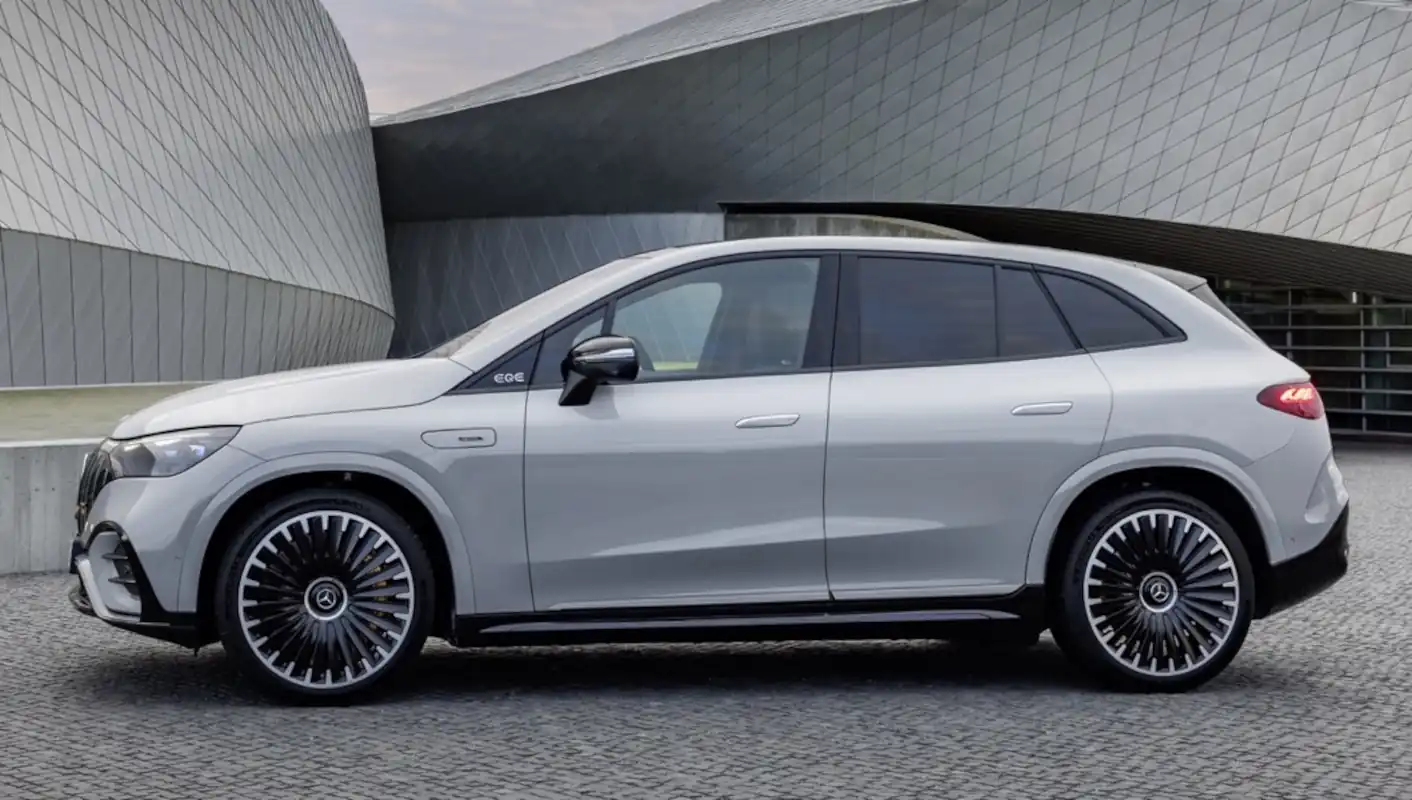
With the premium digital entertainment platform from Californian specialist ZYNC integrated into a vehicle for the first time, customers enjoy a seamless digital entertainment experience. The advantages of the MBUX Hyperscreen are fully exploited. Through ZYNC, customers gain access to a wide range of renowned global and local streaming services. The ZYNC platform focuses exclusively on vehicle interiors, and integrates seamlessly with vehicle hardware and operating systems. This enhances the audio-visual experience, interaction and user-friendliness. ZYNC offers video streaming, on-demand content, interactive experiences, local video programmes, sport, news, games, and much more besides, via a single user interface.
Performance-oriented drive concept with two electric motors
Both new Mercedes-AMG EQE SUV models offer a performance-oriented drive concept with two electric motors. The powerful electric powertrain (eATS) with a motor at the front and rear axle also offers fully variable all-wheel drive, which optimally transmits the drive power to the road in all driving conditions. The power spectrum ranges from 350 kW (476 hp) in the EQE 43 4MATIC to 505 kW (687 hp) in the EQE 53 4MATIC+ with optional AMG DYNAMIC PLUS Package with Boost function. The maximum torque ranges from 858 to 1000 Nm.
The AMG-specific electric motors at the front and rear axles are permanently excited synchronous motors (PSM). The decided emphasis on performance is already evident in the output and torque values. In addition, the electric motors are characterised by an optimal balance of power increase, efficiency and noise comfort. The electric motors of the EQE 43 4MATIC SUV feature AMG-specific tuning and control. The EQE 53 4MATIC+ SUV uses AMG-specific electric motors with adapted windings, different laminations, higher currents and adapted inverters. This allows higher motor speeds and thus even more power, which is particularly noticeable during acceleration and in the top speed.
The electric motor on the rear axle is particularly powerful thanks to its six-phase design, based on two windings with three phases each. The stator with pull-in winding ensures a particularly strong magnetic field.
Added to this is the highly resilient thermal concept, which allows repeated acceleration manoeuvres with consistently high performance. The centrepiece of the sophisticated design is the so-called water lance in the shaft of the rotor, which cools it. Other AMG-specific cooling elements in the cooling circuit include special ribs on the stator and the needle-shaped pin-fin structure on the inverter, which is made of high-performance ceramics. In addition, there is the transmission oil heat exchanger: In addition to cooling, the oil is also preheated during cold starts to increase efficiency.
Fully variable all-wheel drive AMG Performance 4MATIC and 4MATIC+
The power of the engines is brought to the road by the standard-fit AMG Performance 4MATIC (EQE 43) or 4MATIC+ (EQE 53) fully variable all-wheel drive. In contrast to previous usage, the “+” in 4MATIC+ stands not only for the fully variable all-wheel drive that EQE 43 and EQE 53 both have, but for the entire additional performance and dynamism that the EQE 53 offers. In both models, the system continuously distributes drive torque between the front and rear axles depending on the driving situation: compared to a mechanical all‑wheel drive system, the electric-specific system ensures a significantly faster response. The torque is checked 160 times per second and adjusted if necessary. The torque distribution depends on the selected drive program: in the “Comfort” program the focus is on maximum efficiency, while in “Sport” and “Sport+” the torque is more rear-biased in the interests of greater lateral dynamics.
AMG RIDE CONTROL+ suspension with Adaptive Damping System
The AMG RIDE CONTROL+ suspension with air suspension and Adaptive Damping System is based on four-link suspension at the front and multi-link independent suspension at the rear, each optimised with AMG‑specific wheel carriers, suspension links and anti-roll bars with greater rigidity. In its basic features it corresponds to the suspension of the AMG EQS and the AMG GT four-door Coupé, but its set-up has been adapted to the AMG EQE SUV. The rear axle carrier is connected to the bodyshell with 50 per cent stiffer bearings and reduced bearing clearance to create even more direct road contact. The AMG engineers have specifically tuned all components to meet the special requirements of Mercedes-AMG customers. This applies to ride comfort as well as driving dynamics.
The Adaptive Damping System uses two pressure limiting valves. These continuously variable control valves located outside the damper allow the damping force to be adjusted even more precisely to different driving conditions and drive programs: one valve controls the rebound phase, i.e. the force generated when the wheel rebounds; the other controls the compression phase when the wheel compresses. The rebound and compression phases are controlled independently of each other. This technology makes it possible to increase comfort on the one hand, but also to make the driving dynamics even sportier on the other hand.
The suspension control unit analyses data – including data from the acceleration and wheel path sensors – to adjust the damping force for each wheel in a few milliseconds to suit the situation. The AMG developers were able to significantly increase the spread between sportiness and comfort. Among other things, by widening the spread between minimum and maximum damping force characteristics, as well as even greater flexibility in characteristic mapping. By using the two adjustment valves, the damper is able to provide damping force adjustment across the full range of wheel vibrations. Thanks to the special design of the valves, the damper reacts quickly and sensitively to changing road surfaces and driving conditions.
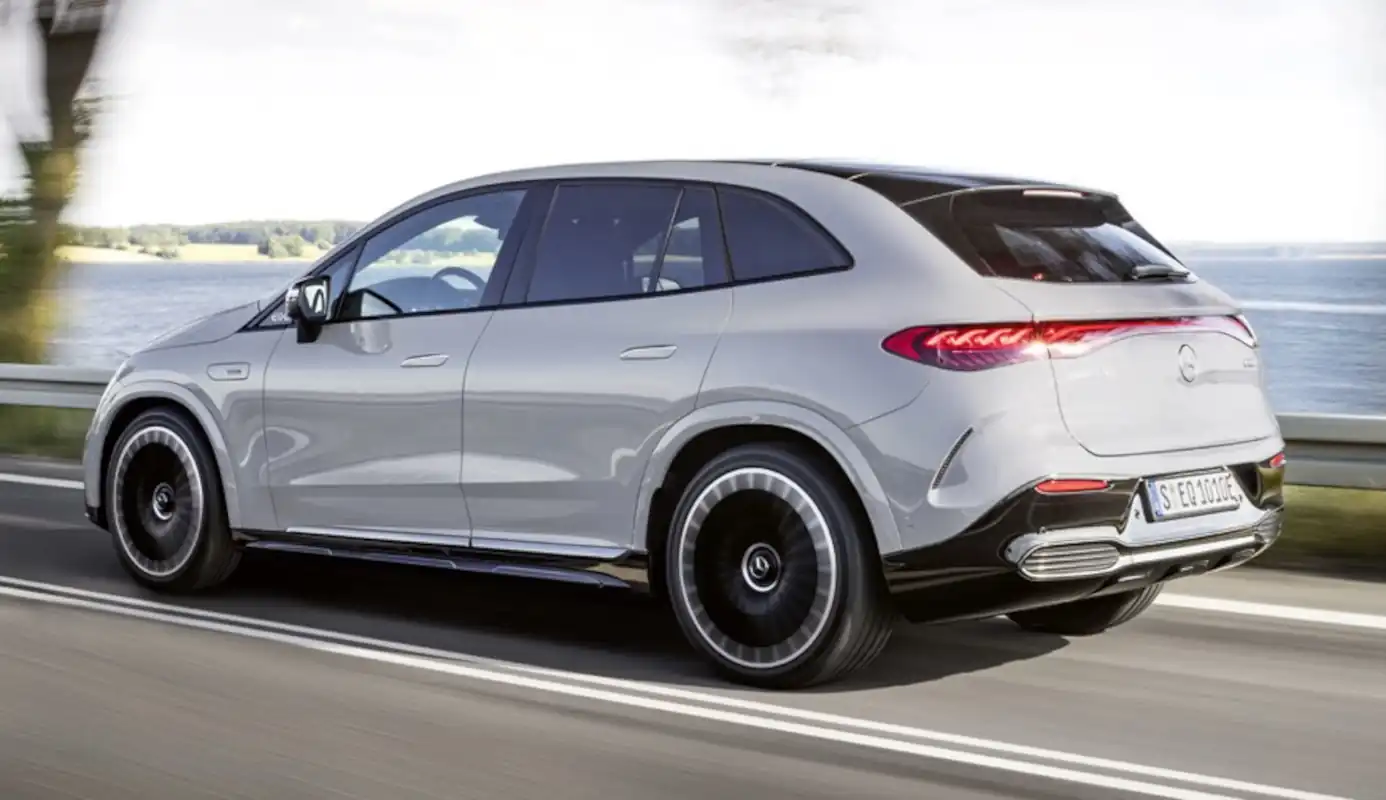
Efficiency also feeds into the intelligent driving level control, which enables better aerodynamics and lower power consumption. In the S and S+ drive programs, the Mercedes-AMG EQE SUV models already adopt the low suspension level from 0 km/h (-15 mm). In drive program C, speed-dependent control takes place with lowering from 120 km/h and raising from 80 km/h.
The special tyres, which are specifically adapted to the requirements of the all-electric AMG Performance vehicles, also contribute to the high dynamic potential. Among other suppliers, the MICHELIN Pilot Sport EV MO1 tyre specifically designed for electric-drive performance vehicles is worth mentioning. It is available in 21 or 22 inch size and features low rolling resistance combined with very high grip levels on wet and dry roads.
With active rear-axle steering as standard
Both Mercedes-AMG EQE SUV models are equipped with active rear-axle steering as standard. The steering angle of up to 9.0 degrees promotes agile handling and allows a turning circle of 10.9 metres. The interaction between front-axle and rear-axle steering is designed to achieve agile response with little steering effort when driving in town or on country roads. At speeds below 60 km/h, the rear wheels steer in the opposite direction to the front wheels. As a result, the Mercedes-AMG EQE SUV is agile, light-footed and nimble. The effect is particularly positive when making a turn, changing direction quickly or manoeuvring slowly. At speeds above 60 km/h, the rear wheels steer in the same direction as the front wheels. The resulting virtually extended wheelbase offers increased handling stability and driving safety at high speeds, and during fast lane changes or sudden evasive manoeuvres.
AMG ACTIVE RIDE CONTROL: electromechanical active roll stabilisation(AMG EQE 53 4MATIC+ SUV only)
Instead of using conventional anti-roll bars, the active roll stabilisation in the AMG EQE 53 4MATIC+ SUV compensates body movements electromechanically. For this purpose, the anti-roll bars on the front and rear axles are divided into two parts. In the centre is an electromechanical actuator in which a three-stage planetary gear is integrated. If the road surface is uneven, the actuator actively separates the stabiliser halves, which increases ride comfort. During dynamic driving, the halves join together and are twisted against each other. This significantly reduces rolling movements In order to meet the high performance requirements of Mercedes-AMG, the system is based on an additional 48-volt auxiliary power system The AMG developers redesigned the rear section of the vehicle to accommodate the roll stabilisation system.
Advantages of the electromechanical roll stabilisation:
- Greater spread between comfort and sportiness than with a mechanical solution
- Precisely compensates for body movements. Even in sporty situations near the limits, the handling remains precisely controllable and direct
- Not only reduces rolling movements when cornering, but also allows more precise tuning of the cornering and load change characteristics
- Increased ride comfort when driving in a straight line because excitations due to one-sided road bumps are balanced out
- Significantly faster response than hydraulic systems
- Lower weight of components compared to hydraulic solutions.
For an individual driving experience: AMG DYNAMIC SELECT drive programs
The driving characteristics can be changed by the driver at the touch of a button to suit the respective situation or their own preferences. This is made possible by the five AMG DYNAMIC SELECT drive programs “Slippery”, “Comfort”, “Sport”, “Sport+” and “Individual”. The drive programs cover a wide spectrum, from high comfort to pronounced sportiness. Important parameters such as drive and performance characteristics, suspension settings, AMG DYNAMICS with, among other things, steering torque characteristics and AMG SOUND EXPERIENCE are modified to suit the selected drive program. The maximum drive power can be called up in the Sport+ drive program, or in all drive programs by kick-down. In the drive programs (except Sport+), the maximum power is adjusted to increase efficiency and reduce fuel consumption.
| EQE 43 4MATIC SUV | EQE 53 4MATIC+ SUV | |
| Slippery | 50% output (=175 kW) | 50% output (=230 kW) |
| Comfort | 85% output (=300 kW) | 80% output (=368 kW) |
| Sport | 90% output (=325 kW) | 90% output (=414 kW) |
| Sport+ | 100% output (=350 kW) | 100% output (=460 kW) |
| RACE START without Boost function | 100% output (=350 kW) | 100% output (=460 kW) |
| RACE START with Boost function (included in AMG DYNAMIC PLUS Package) | not available | 110% power (=505 kW) |
The driver can also pre-select the basic suspension setup via the AMG DYNAMIC SELECT drive programs: at the touch of a button, the driving style varies from maximum dynamics in “Sport+” mode to smooth gliding in the “Comfort” setting, for example. In addition, the tuning can be adjusted in three stages independently of the drive programs via a dedicated button.
Depending on the drive program, the central drive control unit automatically activates different de-rating and cooling strategies: in “Sport” and “Sport+”, the cooling system is activated sooner and the cooling capacity is increased to maintain delivered power for longer. The driver has the option of even more driving pleasure – for example on dedicated race tracks – by using the ESP OFF function.
AMG high-performance brake system
The AMG high-performance brake system with six-piston brake callipers and 415×33 millimetre brake discs at the front and single-piston brake callipers and 378×22 millimetre brake discs at the rear delivers first-class deceleration values with high fade-resistance and endurance. The optional AMG ceramic high-performance composite brake system uses even larger brake discs measuring 440×40 millimetres at the front. Another high-tech feature is the intelligent, electromechanical brake booster iBooster. It ensures that the brake system combines electric recuperation with the hydraulic brake highly efficiently. For the authentic driving experience, the iBooster is specially tuned to the typical AMG pedal response and the AMG brake system.
AMG SOUND EXPERIENCE: unique sound experience with a wide band
With AMG SOUND EXPERIENCE, the performance and sports car brand is giving a new voice to electric mobility – a soundtrack for outside and inside that emotionally enhances the dynamic driving experience. Like the drive programs, the acoustic composition has a wide band: in the standard basic version “Authentic”, the customer can regulate the sound and its intensity depending on the driving status and the selected drive program. The hallmark AMG driving sounds are generated with the help of additional hardware, including special speakers, a bass actuator and a sound generator. Another option for even more individuality: using the AMG steering wheel buttons or the central display, the driver can select the sound characteristics “Balanced”, “Sport” and “Powerful” in each drive program. During RACE START, the vehicle produces a unique sound to match the dynamic acceleration.
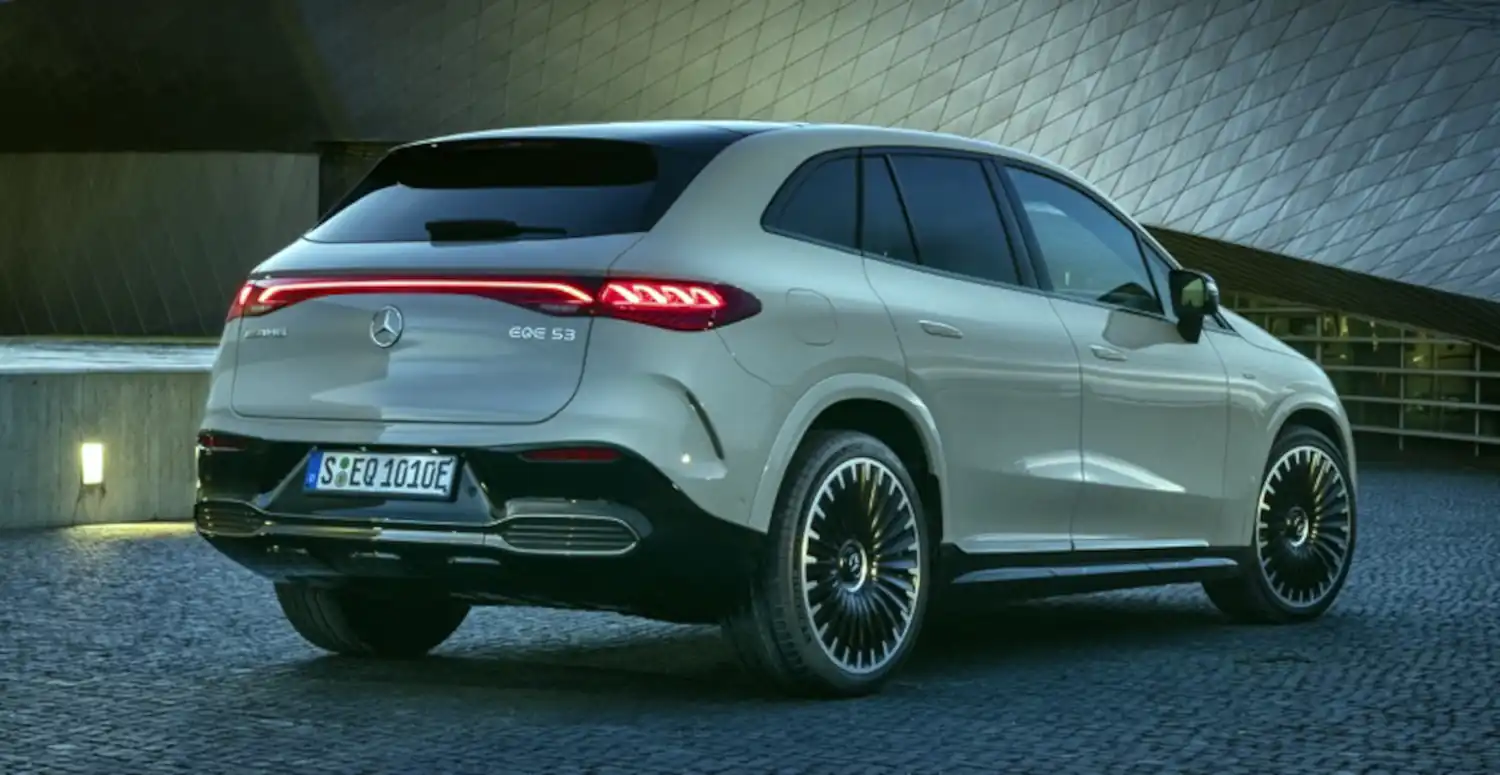
The AMG DYNAMIC PLUS Package also includes the AMG SOUND EXPERIENCE “Performance”, which creates an even more emotional soundscape, also optionally “Balanced”, “Sport” or “Powerful”. In addition to the drive sounds, it also includes most of the so-called event sounds – suitable sounds for all vehicle functions that emit a sound. This includes locking the vehicle, as well as starting and stopping the motor. The program even simulates the click of the indicators, because many drivers are unwilling to do without the familiar sound. A brand new feature is the AMG-specific event sound that is heard when the vehicle is locked. The event sounds can be deactivated at any time via the multimedia system settings – separately for the exterior and interior.
AMG DYNAMIC PLUS Package with dynamic driving extras
The AMG DYNAMIC PLUS package available as an option for the EQE 53 4MATIC+ SUV combines extra dynamic features – including the powerful boost for RACE START, an increase in maximum speed to 240 km/h and the emotional AMG SOUND EXPERIENCE “Performance”. Sounds composed especially for this sound world – for charging or infotainment functions, for example – round off the AMG experience.
The driving dynamics deliver what the sound promises: if the temperature and state of charge are suitable, the maximum power and torque for RACE START can be briefly increased. The Mercedes‑AMG EQE 53 4MATIC+ SUV then takes just 3.5 seconds to sprint from 0 to 100 km/h. The onboard bass actuator and speakers make the power of the electric motors clear even when stationary, and provide an emotionally charged sound backdrop to the high acceleration. The AMG-specific graphics in the displays also visually underscore the driving performance. The AMG Sound Experience can also be deactivated at any time via the settings of the multimedia system, and separately for the outside and inside.
Further options for even more dynamism
Numerous AMG options enhance the dynamic impression if required. These include design features such as the AMG Night package with elements in black and black chrome, red brake callipers or the AMG carbon trim. The high-performance AMG EQE SUV models can also be further refined in terms of driving dynamics, for example with the AMG ceramic high-performance composite brake system. There is also a choice of aerodynamically optimised 20- and 21-inch AMG light-alloy wheels.
AMG TRACK PACE, the virtual race engineer, is also available as an option: the software is part of the MBUX infotainment system and permanently records more than 80 vehicle-specific data (e.g. speed, acceleration), for example while driving on a race track. On top of this, lap and sector times are displayed, as well as the respective difference from a reference time. Because specific display elements are shown in green or red, drivers are able to see at a glance without reading numbers whether they are currently faster or slower than the best time. The data are displayed on the multimedia display, in the instrument cluster and on the optional head-up display.
High-performance drive battery with a capacity of 90.6 kWh
The new Mercedes-AMG EQE SUV models are equipped with a powerful 328-volt high-performance drive battery manufactured using the latest lithium-ion technology. It has a usable energy content of 90.6 kWh and consists of ten modules with a total of 360 pouch cells. The battery management system in the EQE 53 SUV is also tuned specifically for AMG. In the Sport and Sport+ drive programs the focus is on performance, in the Comfort drive program the focus is on operating range. The battery generation is characterised by a high energy density and has a high charging capacity. Another new feature is the possibility to install updates for the battery management system over-the-air for continuous improvements over the life cycle. The EQE 53 4MATIC+ SUV also features an AMG-specific wiring harness adapted to the higher performance capability. A major advance in sustainability has been achieved in the cell chemistry: the cobalt content is reduced to ten percent, while the optimised active material consists of nickel, cobalt and manganese in a ratio of 8:1:1.
Short charging times through intelligent thermal management
Another advantage of the new battery generation is the short charging times. The energy storage system can charge with up to 170 kW at fast charging stations with direct current. In this case, electricity for up to 170 kilometres (WLTP) can be recharged in just 15 minutes[2]. Thanks to the onboard charger, the electrified AMG can be conveniently charged at home or at public charging stations with 11 kW or optionally 22 kW with alternating current. In Japan, bidirectional charging will also be possible, i.e. charging in both directions. In addition, there are intelligent charging programs that can be activated automatically depending on the location. Functions such as battery-saving charging make operations even more efficient.
The efficient thermal management also plays a part in shortening charging times. If the intelligent navigation with Electric Intelligence is activated, the battery is preheated or cooled while driving to reach the optimal temperature for fast charging at the charging point. The desired temperature range of the battery is achieved with the aid of the cooling circuit and a PTC (Positive Temperature Coefficient) booster heater integrated into it.
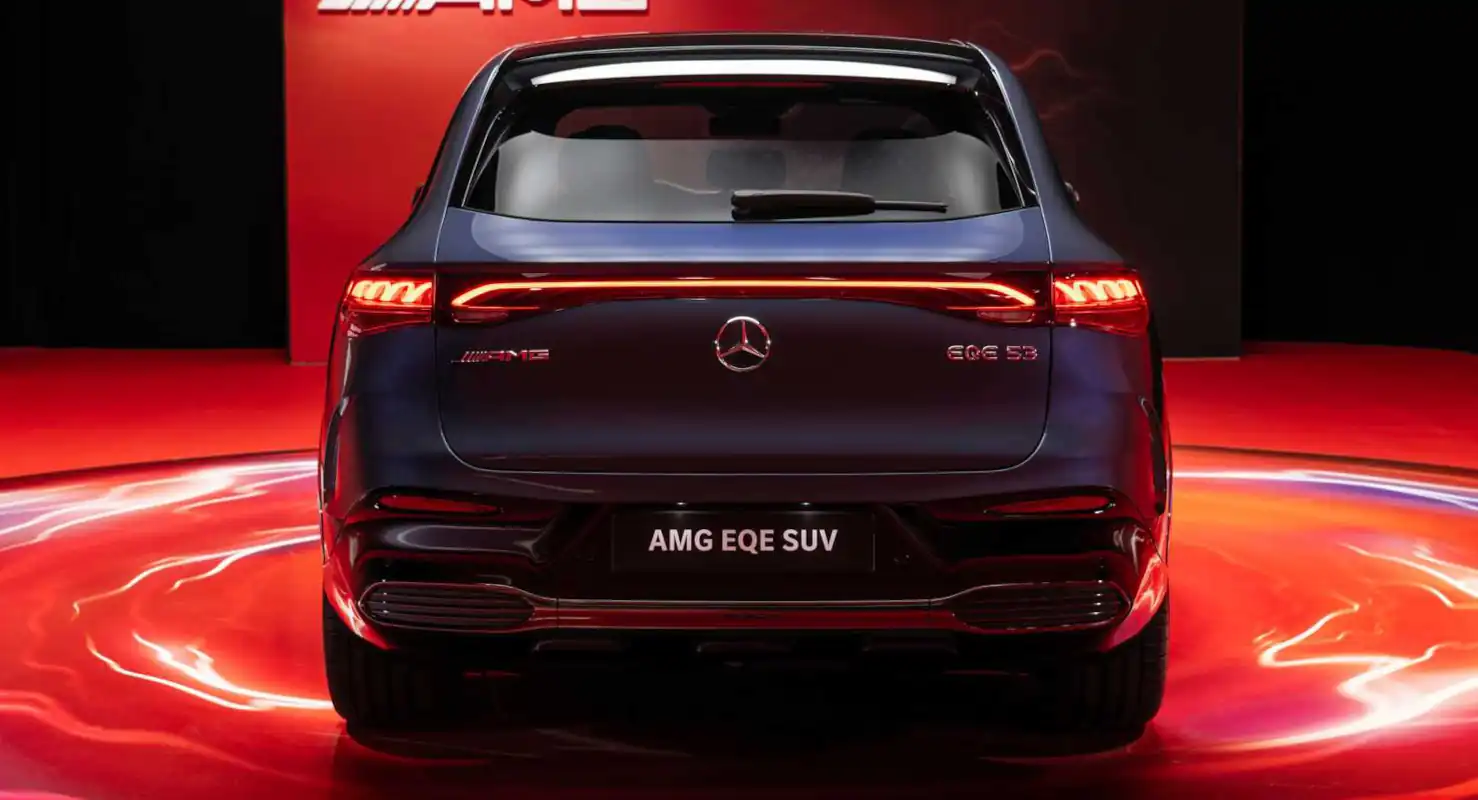
The battery design aims to ensure the optimum battery operating temperature under all operating conditions. The aluminium extrusions of the battery frame have defined cavities through which the coolant flows. All in all, the intelligent temperature and charging management ensures that high charging currents can be maintained for a long time. The standard heat pump uses the waste heat from the electric drive (inverter and electric motor) and the high-voltage battery to heat the interior. This reduces the need for battery power for interior heating, and thus increases the range. Another function is pre-entry climate control.
The battery also stands out for its durability. The ECO Charging function makes a significant contribution to this: the intelligent control reduces the battery load during charging, and thus slows down the natural ageing process of the battery. Customers can also benefit from the “charging interruption” function: the charging process can be paused at freely selectable times so as to use cheaper off-peak electricity at a later time, for example. The battery certificate stands for the long service life of the high-voltage batteries. It is valid for up to ten years or up to 250,000 kilometres.
Intelligent recuperation for efficient energy recovery
The battery can also be charged through efficient energy recovery using recuperation. The recuperation power reaches up to 260 kW[3]. The driver can adjust the level of recuperation in three stages via switches on the steering wheel, and receive situation-optimised support from ECO Assist. Here, one-pedal driving and combined braking to a standstill are possible in recuperation levels D and D-. In DAuto, up to 5 m/s² deceleration is achieved, 3 m/s² of which is due to recuperation (2 m/s² via the AMG high-performance brake system). With the help of the optional DRIVE PILOT, deceleration is automatic in response to detected vehicles ahead until they come to a standstill, for example at traffic lights.
Sustainable use of electrical power thanks to Mercedes me Charge
With Mercedes me Charge, customers can always be sure of “green” charging at every public charging station throughout Europe as of 2021. High-quality guarantees of origin ensure that as much green power from renewable energies is fed into the grid as is withdrawn via Mercedes me Charge. In the first three years after the purchase, there is no basic fee for Mercedes me Charge and thus Green Charging for customers. Another advantage is IONITY Unlimited: All European EQE SUV customers can use the IONITY fast charging network free of charge for one year via Mercedes me Charge. The new Plug & Charge function makes charging the AMG EQE SUV particularly convenient.
Mercedes me Charge is currently the largest charging network worldwide: It currently has more than 500,000 AC and DC charging points in 31 countries, including over 200,000 in Europe. Also included are the 336 fast‑charging stations of the IONITY fast-charging network co-founded by Mercedes-Benz. In addition, the functionality of Mercedes me Charge in MBUX has been expanded to include functions such as filtering and forecasting the availability of charging stations.
Mercedes me App: easy to use on smartphone and tablet
The Mercedes me App offers many improved and new functions since the last revision. These include a filtering option that allows the charging points to be sorted according to criteria such as availability or charging capacity. The app now also shows how busy the respective charging station is likely to be during the course of the day, based on a probability calculation.
Predictive route planning and efficient driving with Electric Intelligence
When it comes to navigation with Electric Intelligence, the name says it all. Because it plans the fastest and most convenient route, including charging stops, based on numerous factors and reacts dynamically to traffic jams or a change in driving style, for example. Electric Intelligence plans a fast and comfortable route in advance, including charging stops based on numerous factors such as the calculated energy requirement. The system includes all relevant data in the calculation, from topography and route to driving speed and heating/cooling requirements.
With Electric Intelligence, the new AMG EQE SUV models also react dynamically to the traffic situation on the planned route. The AMG vehicle records traffic tailbacks and road closures, as well as changes in energy demand. For its calculations the system uses information from the cloud, which it combines with onboard data. The planned route can be edited individually. For example, the customer can set the additional reserve at the destination and at the charging station (SoC, State of Charge) – ten percent SoC is standard. If the “Charge at destination” function is selected, the set reserve may be undercut until the destination is reached. MBUX indicates whether the available battery capacity is sufficient to drive back to the starting point without charging.
Further options for individual route planning:
- The route calculation prefers manually added charging stations along the route
- The driver can exclude suggested charging stations
- Calculation of the expected charging costs per charging stop
If there is a risk of not reaching the destination or the charging station with the chosen settings, MBUX informs the driver in good time with a note to activate the ECO driving functions, thanks to “Active range monitoring”.
Comprehensive safety concept: Battery is crash-protected in the underbody
The battery sits in a crash-protected area in the underbody, embedded in the bodyshell structure and including an extruded aluminium profile to the side. During extrusion, a heated block of metal is pushed through the dies and turns into an endless section, which is then cut to fit. This makes highly complex profiles that are precisely tailored to the requirements possible. The housing with energy absorbing structures at the front and side, as well as a rigid, double-walled base plate, provide additional protection for the modules. In addition, there is a separate, multi-level safety system for everyday operation. This includes, for example, temperature, voltage or insulation monitoring. If a fault occurs, the battery switches off. Crash monitoring when stationary is also standard.
Technical data
Mercedes-AMG EQE 43 4MATIC SUV
| Drive system and battery | |||
| Electric motors | Type | Two permanently excited synchronous motors | |
| Rated output | kW (hp) | 350 (476) | |
| Rated torque | Nm | 858 | |
| Drive system | Fully variable all-wheel drive AMG Performance 4MATIC | ||
| Battery type | Lithium-ion | ||
| Rated voltage | V | 328 | |
| Battery energy content, usable | kWh | 90.6 | |
| Recuperation capacity, max. | kW | 260 | |
| AC charging capacity, max. (series/optional) | kW | 11/22 | |
| DC charging capacity, max. | kW | 170 | |
| Suspension | |||
| Front axle | AMG RIDE CONTROL+ with four-link front suspension, air suspension strut, Adaptive Damping System | ||
| Rear axle | AMG RIDE CONTROL+ five-link independent rear suspension, air suspension strut, Adaptive Damping System | ||
| Brake system | Dual-circuit hydraulic brake system; front: 415×33 mm brake discs, internally ventilated and perforated, 6-piston aluminium fixed calliper; rear: 378×22 mm brake discs, internally ventilated and perforated, 1-piston aluminium sliding calliper; electric parking brake, ABS, Brake Assist, 3-stage ESP® | ||
| Steering | Electromechanical speed-sensitive power steering with rack and pinion, variable steering ratio (12.8:1 at dead centre) and variable power assistance, standard rear-axle steering (9.0°) | ||
| Wheels | front 9.5 J x 21 ET42; rear 9.5 J x 21 ET 42 | ||
| Tyres | front Michelin Pilot Sport EV MO1 275/40 R21; rear Michelin Pilot Sport EV MO1 275/40 R21 | ||
| Dimensions and weights | |||
| Number of doors/seats | 4/5 | ||
| Length/[4]/ | mm | 4879/1931/1672 | |
| Wheelbase | mm | 3030 | |
| Track, front/rear | mm | 1654/1659 | |
| Turning circle | m | 10.90 | |
| Boot capacity, VDA | l | 520-1675 | |
| Kerb weight/perm. gross vehicle weight/max. payload | kg | 2600/3195/595 | |
| Perm. towing capacity (braked/unbraked) | kg | 1800/750 | |
| Performance, consumption and range | |||
| Acceleration 0-100 km/h | s | 4.3 | |
| Top speed | km/h | 210 | |
| Combined power consumption (WLTP)[5] | kWh/100 km | 25.1–22.0 | |
| Combined CO2 emissions (WLTP) | g/km | 0 | |
| Range (WLTP)5 | km | 431–488 | |
Mercedes-AMG EQE 53 4MATIC+ SUV
| Drive system and battery | |||
| Electric motors | Type | Two permanently excited synchronous motors | |
| Rated output | kW (hp) | 460 (626)/505 (687) with AMG DYNAMIC PLUS Package | |
| Rated torque | Nm | 950/1000 with AMG DYNAMIC PLUS Package | |
| Drive system | AMG Performance 4MATIC+ fully variable all-wheel drive |
||
| Battery type | Lithium-ion | ||
| Rated voltage | V | 328 | |
| Battery energy content, usable | kWh | 90.6 | |
| Recuperation capacity, max. | kW | 260 | |
| AC charging capacity, max. (series/optional) | kW | 11/22 | |
| DC charging capacity, max. | kW | 170 | |
| Suspension | |||
| Front axle | AMG RIDE CONTROL+ with four-link front suspension, air suspension strut, Adaptive Damping System and active roll stabilisation AMG ACTIVE RIDE CONTROL | ||
| Rear axle | AMG RIDE CONTROL+ five-link independent rear suspension, air suspension strut, Adaptive Damping System and active roll stabilisation | ||
| Brake system | Dual-circuit hydraulic brake system; front: 415×33 mm brake discs, internally ventilated and perforated, 6-piston aluminium fixed calliper; rear: 378×22 mm brake discs, internally ventilated and perforated, 1-piston aluminium sliding calliper; electric parking brake, ABS, Brake Assist, 3-stage ESP® | ||
| Steering | Electromechanical speed-sensitive power steering with rack and pinion, variable steering ratio (12.8:1 at dead centre) and variable power assistance, standard rear-axle steering (9.0°) | ||
| Wheels | front 9.5 J x 21 ET42; rear 9.5 J x 21 ET 42 | ||
| Tyres | front Michelin Pilot Sport EV MO1 275/40 R21; rear Michelin Pilot Sport EV MO1 275/40 R21 | ||
| Dimensions and weights | |||
| Number of doors/seats | 4/5 | ||
| Length/[6]/ | mm | 4879/1931/1672 | |
| Wheelbase | mm | 3030 | |
| Track, front/rear | mm | 1654/1659 | |
| Turning circle | m | 10.90 | |
| Boot capacity, VDA | l | 520-1675 | |
| Kerb weight/perm. gross vehicle weight/max. payload | kg | 2690/3195/505 | |
| Perm. towing capacity (braked/unbraked) | kg | 1800/750 | |
| Performance, consumption and range | |||
| Acceleration 0-100 km/h | s | up to 3.5 (with AMG DYNAMIC PLUS package) | |
| Top speed | km/h | 220 / 240 (with AMG DYNAMIC PLUS Package) | |
| Combined power consumption (WLTP)[7] | kWh/100 km | 27.8–22.6 | |
| Combined CO2 emissions (WLTP) | g/km | 0 | |
| Range (WLTP)7 | km | 375–470 | |
[1]Data on electrical consumption and range are provisional and were determined internally in accordance with the “WLTP test procedure” certification method. Confirmed TÜV figures, EC type approval and certificate of conformity with official figures are not yet available. Differences between the stated figures and the official figures are possible.
[2]Charging time at DC fast-charging stations with 500 amperes. Figures for charging times are provisional and were obtained internally in accordance with the certification method “WLTP test procedure”. Confirmed TÜV figures, EC type approval and certificate of conformity with official figures are not yet available. Differences between the stated figures and the official figures are possible.
[3]This value refers to the electrical power fed into the electric battery due to recuperation. It can be achieved under optimal environmental conditions, depending on, among other things, state of charge and temperature. Deviations are possible.
[4]Without exterior mirrors
[5]Data on electrical consumption and range are provisional and were determined internally in accordance with the “WLTP test procedure” certification method. Confirmed TÜV figures, EC type approval and certificate of conformity with official figures are not yet available. Differences between the stated figures and the official figures are possible.
[6]Without exterior mirrors
[7]Data on electrical consumption and range are provisional and were determined internally in accordance with the “WLTP test procedure” certification method. Confirmed TÜV figures, EC type approval and certificate of conformity with official figures are not yet available. Differences between the stated figures and the official figures are possible.
